APUSH Period 3
1/74
There's no tags or description
Looks like no tags are added yet.
Name | Mastery | Learn | Test | Matching | Spaced |
|---|
No study sessions yet.
75 Terms
The Age of Revolution
The second half of the 18th century was marked by popular protest against monarchy and aristocracy and political upheaval that centered on ideas of liberty and (classical) liberalism. Beginning in British North America (the American Revolution), such political struggles spread to Europe (the French Revolution) and the Caribbean (the Haitian Revolution), and culminated in the Latin American wars for independence.
Effects of the Seven Years War (aka the "French and Indian War")
The war left Britain in tremendous debt, which led to the end of "salutary neglect" and the imposition of new taxes on the colonists. (These taxes would eventually spark the American Revolution.)

The Proclamation Line of 1763
Passed on the heels of the Seven Years War, the British Parliament created this law prohibiting colonists from settling west of the Appalachian Mountains in order to prevent conflict with the Indians and the expense of having to defend them. This was one source of colonial frustration with British rule.
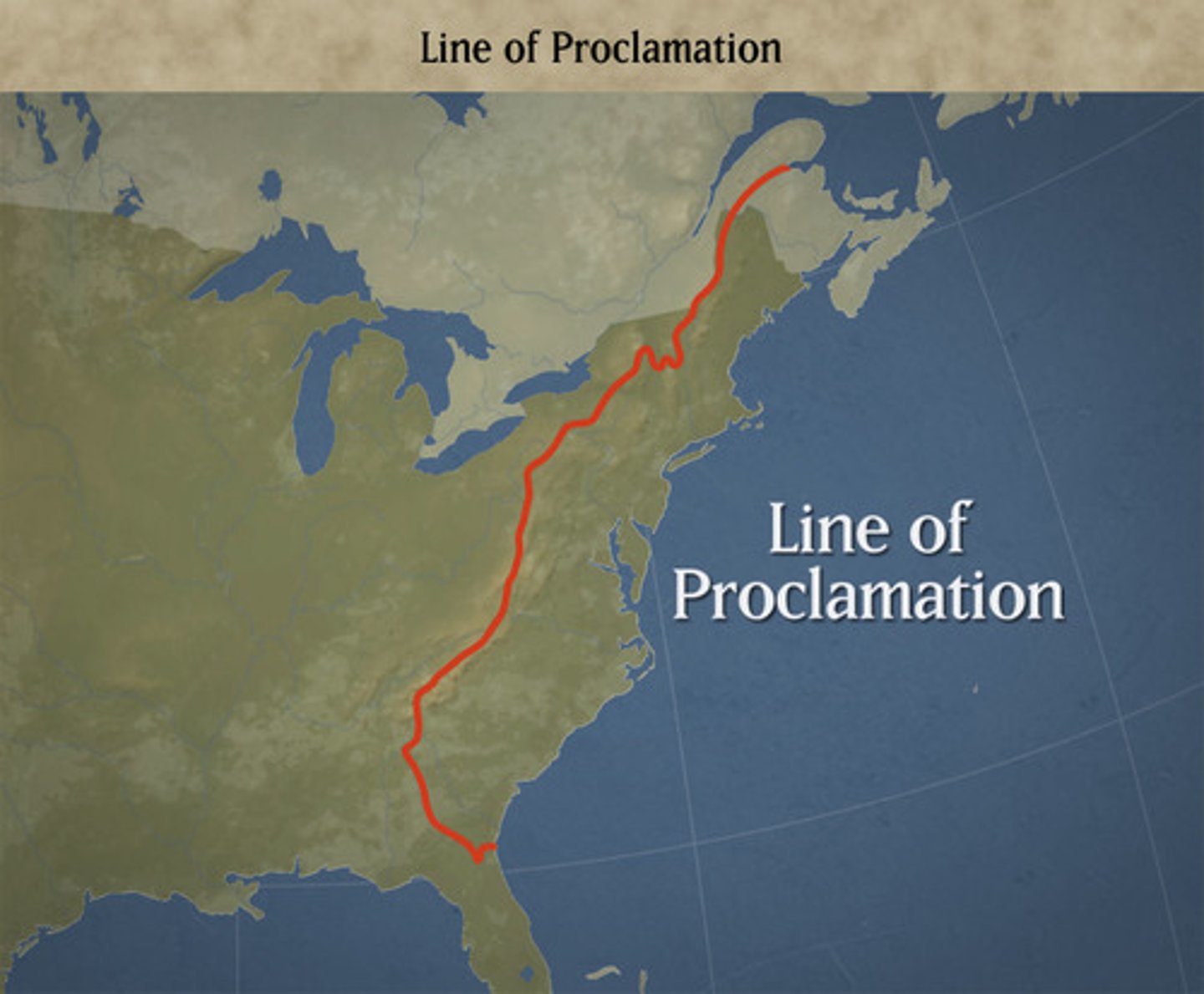
"Virtual Representation"
The theory which held that each member of Parliament represented the entire empire, not just his own district. During the era of the American Revolution, many colonists began to reject this theory and demand "actual representation," by which they meant electing colonists of their own choosing to go to Parliament to represent the colonists.
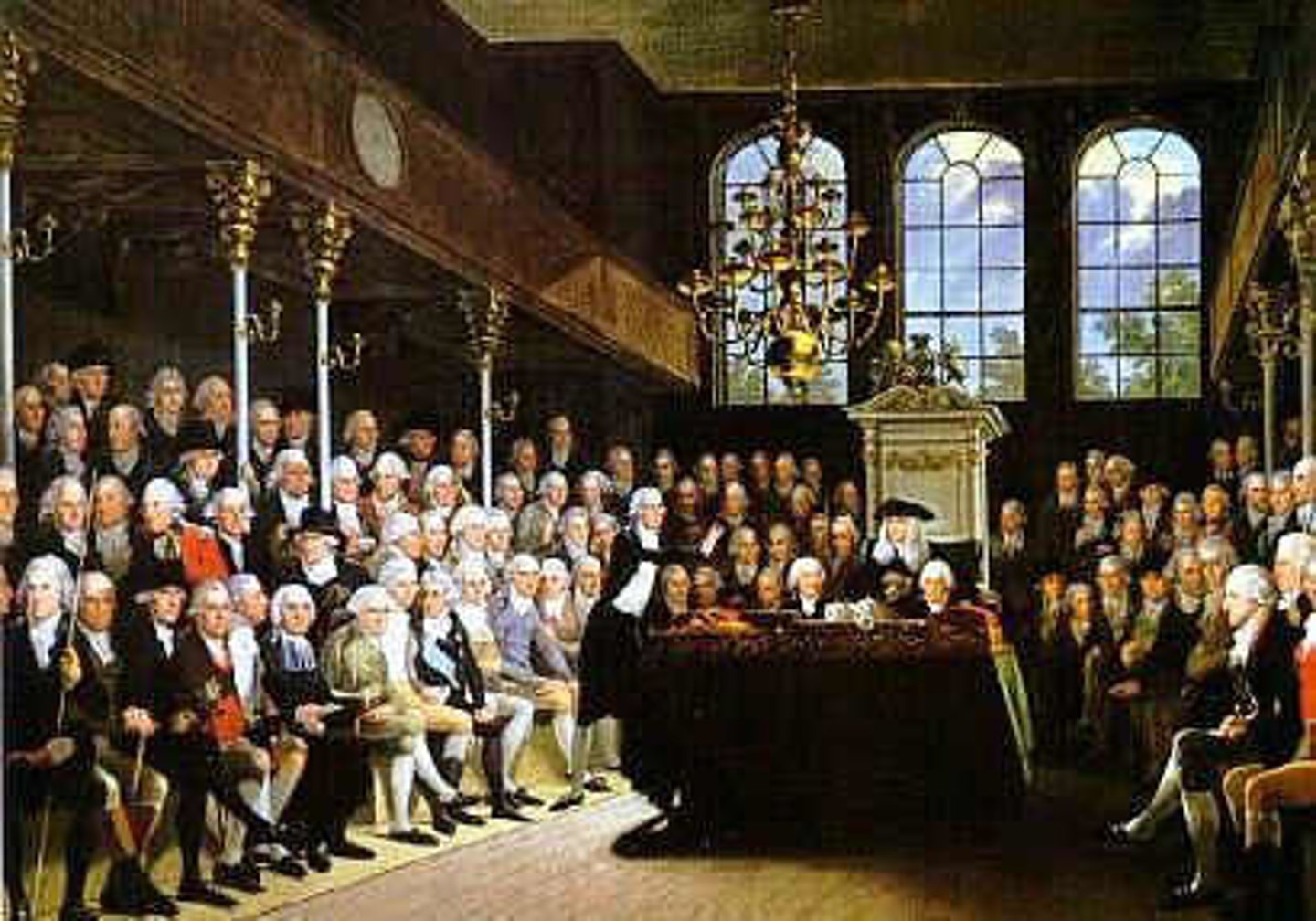
Writs of Assistance
One of the colonies' main complaints against Britain, these allowed the British soldiers to search any colonial ship or building, without warning or limit, to look for evidence of colonial smuggling. (After independence, the founders included the 4th Amendment in the Bill of Rights to defend Americans' property rights against "unreasonable searches and seizures" such as these during the struggle against Britain.)
The Stamp Act (1765)
This was the first direct tax on the internal economic activity within the colonies, and it sparked enormous protests among the colonists. The tax required colonists to buy and affix revenue stamps to all colonial printed materials/books/newspapers, legal documents, and playing cards. It offended a broad range of colonists of all classes and provoked a passionate backlash against the Parliament's taxation of the colonists. Due to angry colonial protest, Parliament repealed this act the after only one year.
Sons of Liberty
Organizations formed by Samuel Adams, John Hancock, and other colonial radicals in response to the Stamp Act that encouraged many lower-class individuals to get involved in public affairs. These organizations brought many people into political affairs who had previously been unengaged.
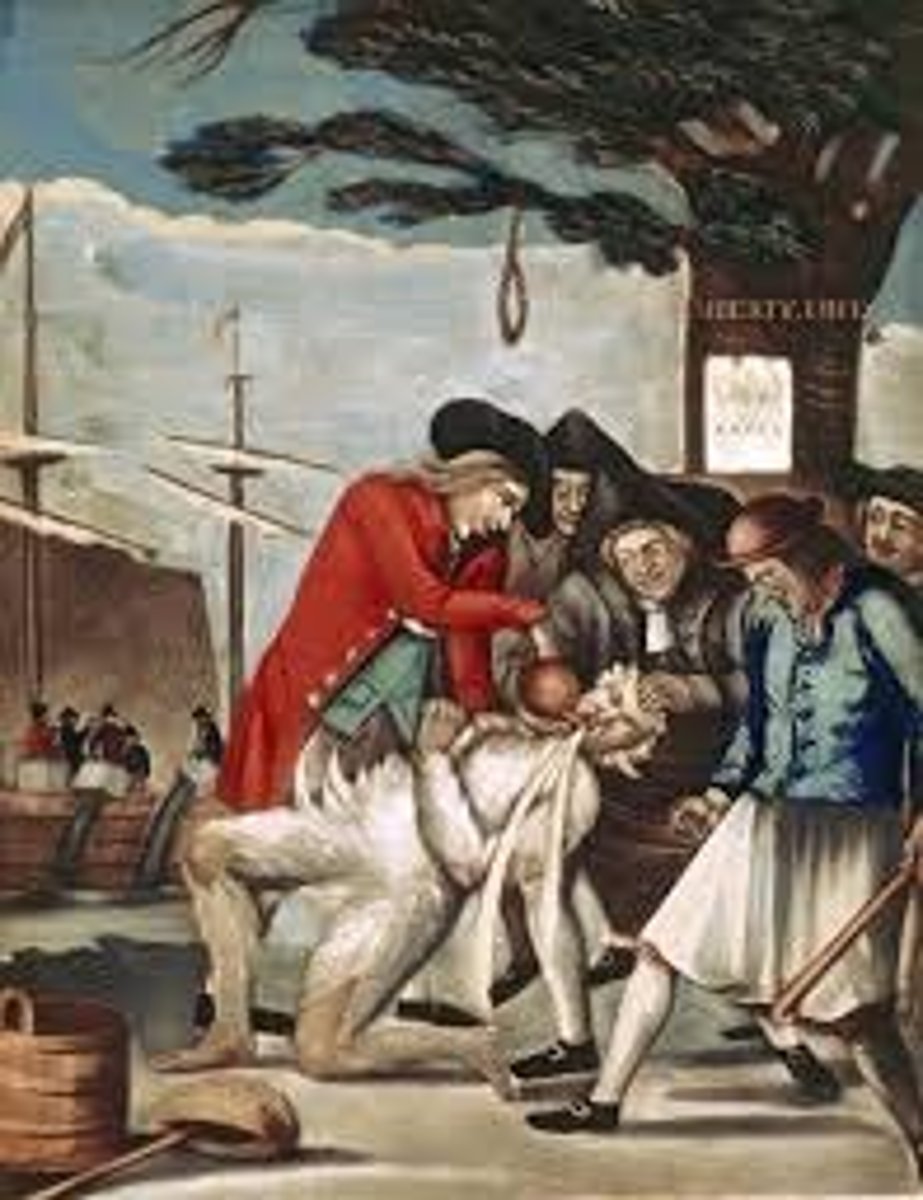
Daughters of Liberty
The female counterparts of the Sons of Liberty, these organizations led the "homespun movement" in which women boycotted (refused to buy) imported clothing, silks, and textiles, and instead, these women produced what they needed for their own families, and eventually they provided uniforms and blankets for Continental soldiers. Even though these groups didn't engage in public protests and riots against the British, they nevertheless illustrate the expanding role of women in political affairs during the Revolutionary Era.
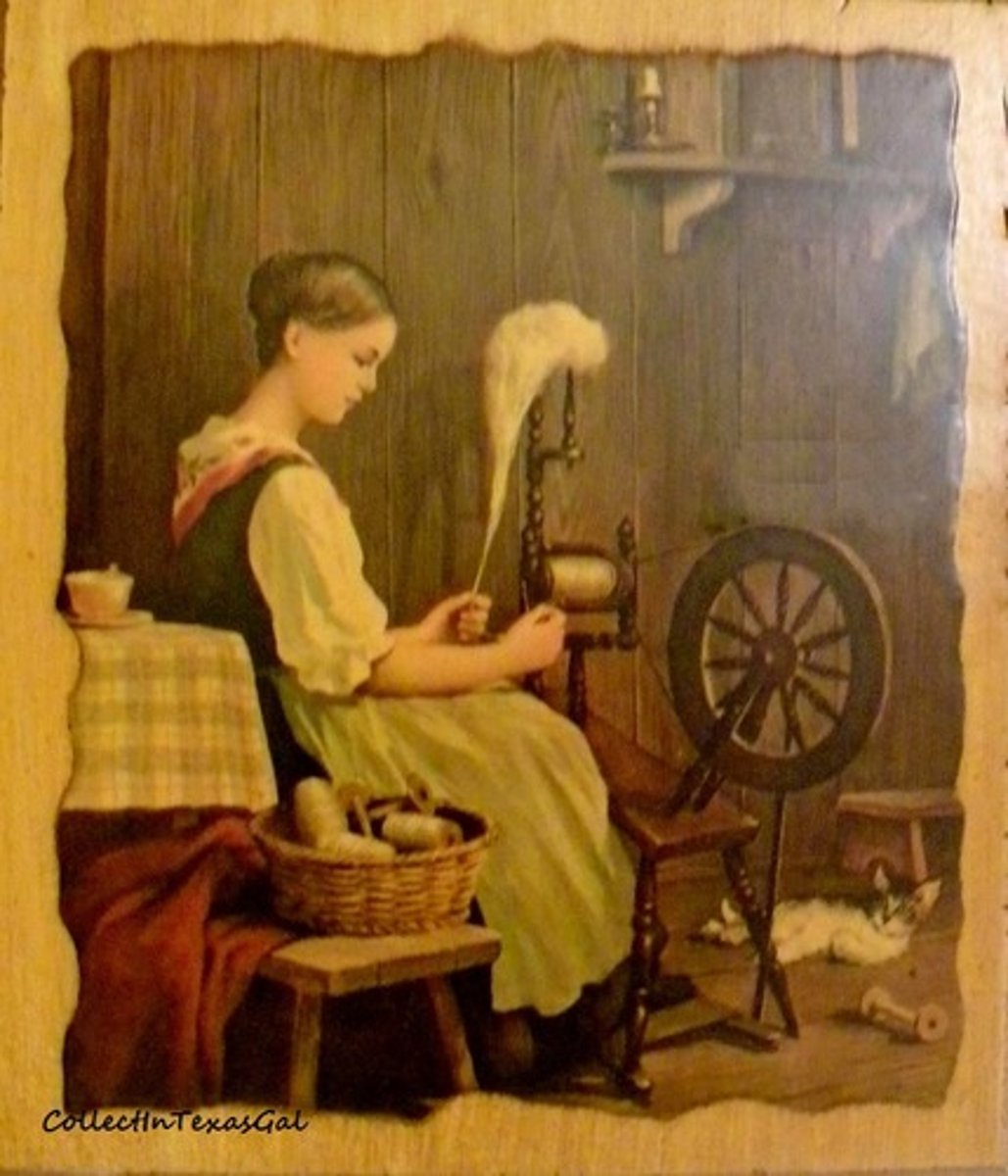
"No taxation without representation"
The key slogan of the American Revolution representing the emerging belief that Britain had no right to tax its colonists because Americans were unrepresented in the British Parliament. This belief was relatively new and emerged from the Enlightenment's principle of "popular sovereignty" (the idea that governments ought to have the consent of their people). In ancient and medieval times all over the world, governments routinely taxed their subjects, and rarely were those subjects represented in their government.
Boston Massacre
A clash that turned deadly between British soldiers and American colonists in the winter of 1770 in which five Americans were killed, sparking anti-British anger and revolutionary zeal throughout the colonies. Paul Revere's famous propagandistic engraving of the event depicted the event as a malicious group of British soldiers deliberately firing into an unarmed, peaceful, and sympathetic group of American civilians.
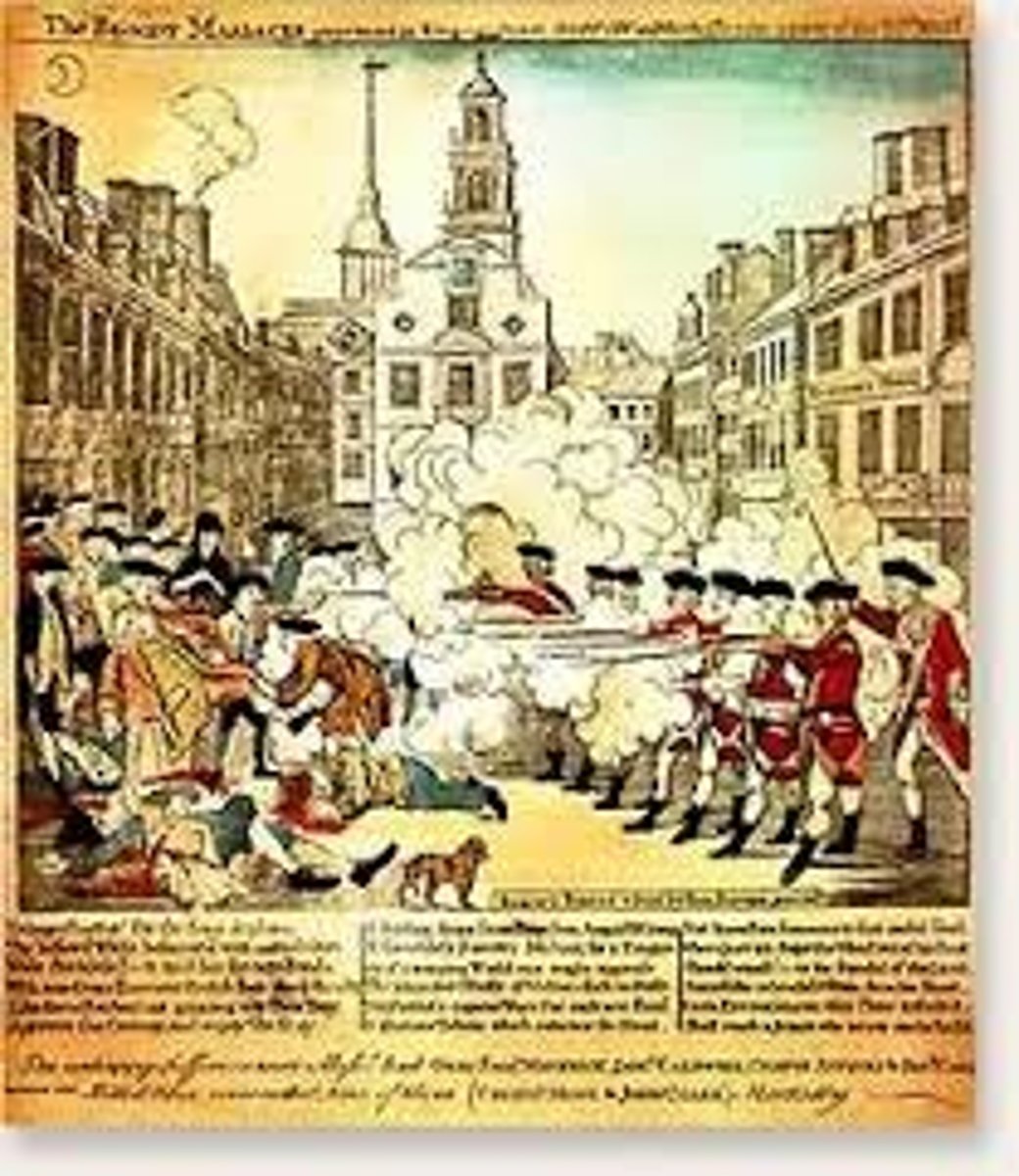
The Boston Tea Party
In 1773, the Sons of Liberty, dressed as Indians, dumped hundreds of chests of tea into Boston Harbor to protest the the British tax on tea, which they saw as a violation of their rights. The British considered the protest an act of treason and responded harshly. These events accelerated and intensified colonial resistance to British taxation, and they became iconic events on the road to the American Revolution.

The Intolerable Acts (1774)
Four harsh acts passed by the British Parliament in response to the Boston Tea Party that 1) closed the port of Boston to all trade until all tea was paid for, 2) radically altered the Massachusetts colonial government by limiting town meetings, 3) and allowing the (appointed) governor to appoint members to the colonial assembly (positions previously elected by the colonists), and 4) empowered military commander to lodge British soldiers in colonists' private homes.
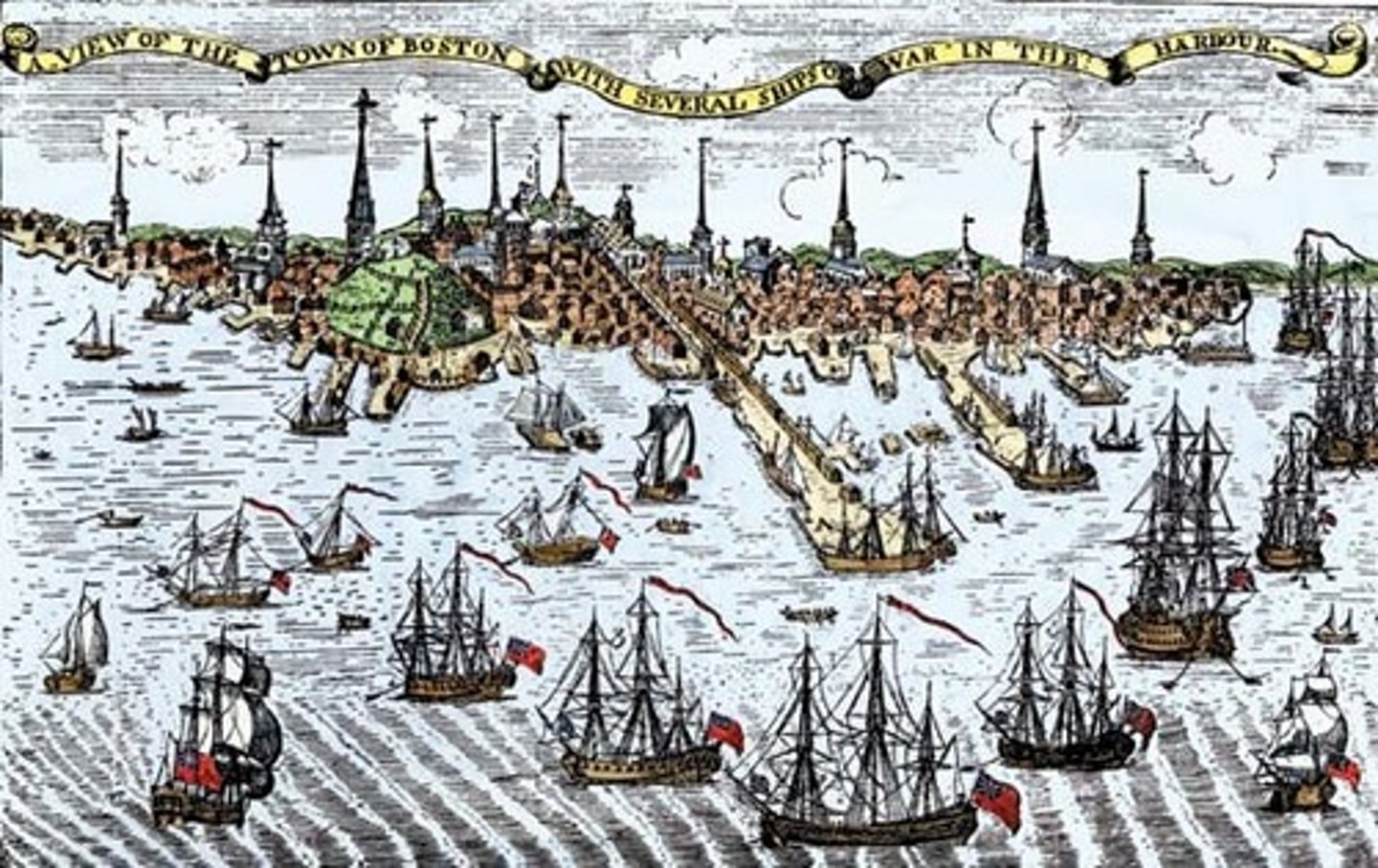
The Continental Congress
The first body of representatives from all thirteen colonies that met periodically from 1774 until 1789 to organized collective action against British policies, and then to conduct the war, adopt the Declaration of Independence and, later, the Articles of Confederation. This was the the first time representatives from all thirteen colonies united together in common cause, and thus it became an important step in the formation of a national republic that would replace the British monarchy in North America.

Thomas Paine's "Common Sense"
A pamphlet written by a radical English immigrant that attacked the British principles of hereditary rule and monarchical government and called for American independence from Britain. (Prior to this, colonial protest aimed at reforming the colonies' relationship with the British, not ending it). The pamphlet was so successful because it was written clearly and directly in ordinary but dramatic language, so all colonists (not just educated elite) could understand and share in colonial resistance to the British. This pamphlet represents the expansion of the political sphere taking place during the American Revolution.
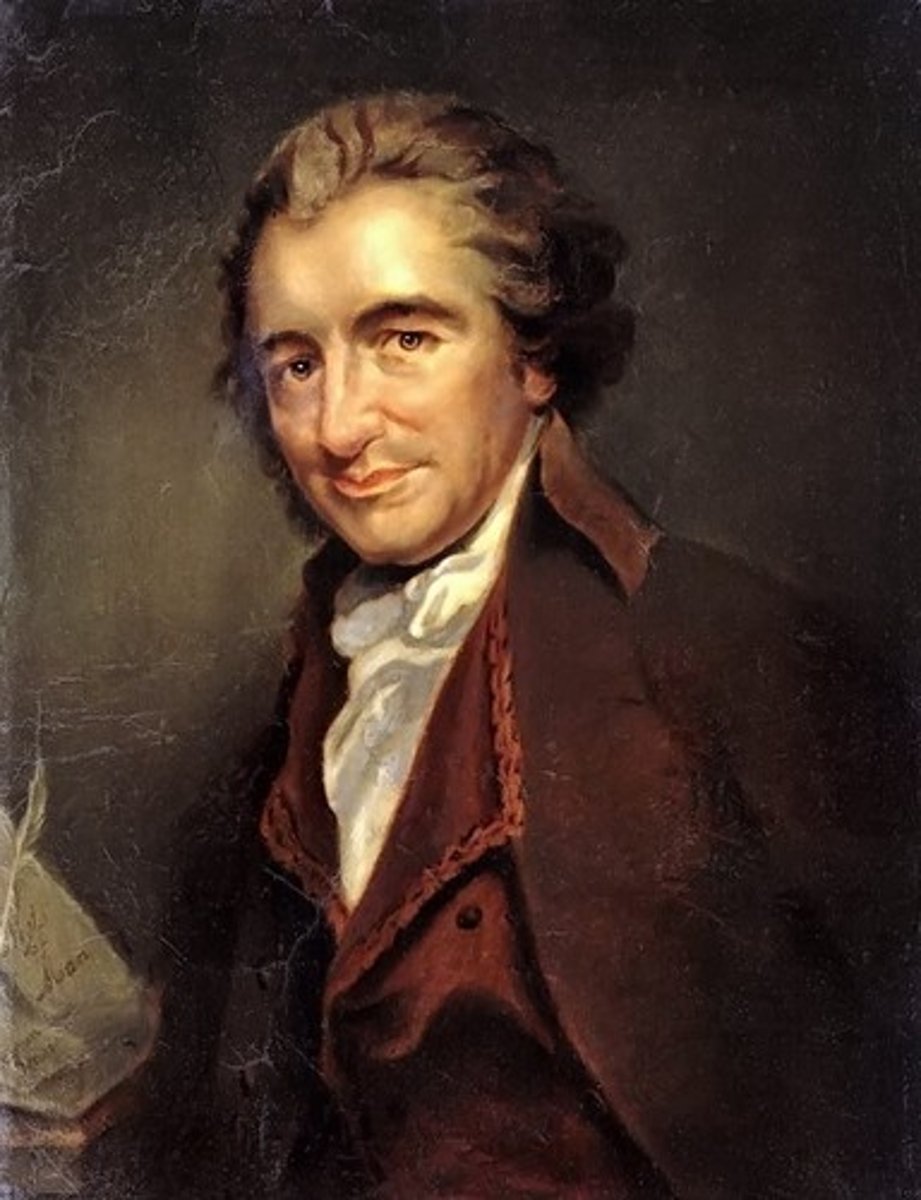
The Declaration of Independence (1776)
Document drafted by Thomas Jefferson and adopted by the Continental Congress on July 4, 1776, that made the break with Britain official, founded the United States, and went on to become one of the most widely circulated, reprinted, and influential documents in all of world history. The document listed colonial grievances after first stating fundamental "self-evident" truths: "all men are created equal and they are endowed by their creator with certain unalienable rights, among these are life, liberty, and the pursuit of happiness." (You should memorize that sentence, APUSHers!) Many historians agree that this document contains contains the most potent and consequential words in all of American history, and it has become "scripture" in the traditions human rights and American civic nationalism by stating a set of ideals that nations can indefinitely strive towards.
Presentism
Judging people far back in history, their behaviors and beliefs, and historical developments that happened long ago by evaluating them against our own current standards and values today, rather than understanding them relative to the prevailing standards and values that actually existed at that time in history. Most modern historians seek to avoid judging the past by modern standards because they consider it fallacious, anachronistic, and a form of cultural bias that creates a distorted understanding of the past.
Ben Franklin
American polymath, writer, printer, scientist, inventor, patriot, founder, abolitionist, and signer of the Declaration of Independence and the U.S. Constitution. Born in the Colonial period, he rose from humble beginnings to achieve greatness on many fronts, demonstrating to Europeans the possibility of becoming a "self-made man" in America. He established the first lending library and fire department in the colonies, and he published a colonial newspaper in Philadelphia. His famous scientific experiment with the key and the kite demonstrated that lightning is actually electricity (previously, people believed lightning was the wrath of an angry god). Additionally, his many inventions (including the lighting rod, which protected buildings from fires caused by lightning) made him an American symbol of both the Enlightenment and the Scientific Revolution. He played a major role in the colonial independence movement, and during the Revolutionary War he persuaded the French to help the patriots by sending soldiers, supplies, and money that proved crucial to the patriot victory.

George Washington
The "Father of his Country," he was the Commander of the Continental Army, and he led Patriot forces to unlikely victory in the Revolutionary War. Astonishingly, rather than making himself King after defeating the British, he retired to his plantation in Virginia, demonstrating his commitment to republican principles. Drawn back into politics later, he provided legitimacy to the Constitutional Convention in 1789 and was twice elected President unanimously by the Electoral College. As the first President of the United States, he set many important precedents, including the peaceful transfer of power and the two-term tradition. Popular and scholarly polls consistently rank him as one of the best presidents in American history.

Treaty of Paris (1783)
The 1783 treaty that ended the Revolutionary War, in which the British formally recognized American independence and established the border between Canada and the United States, fixed the western border at the Mississippi River. Native Americans were not consulted, nor did they sign the treaty.
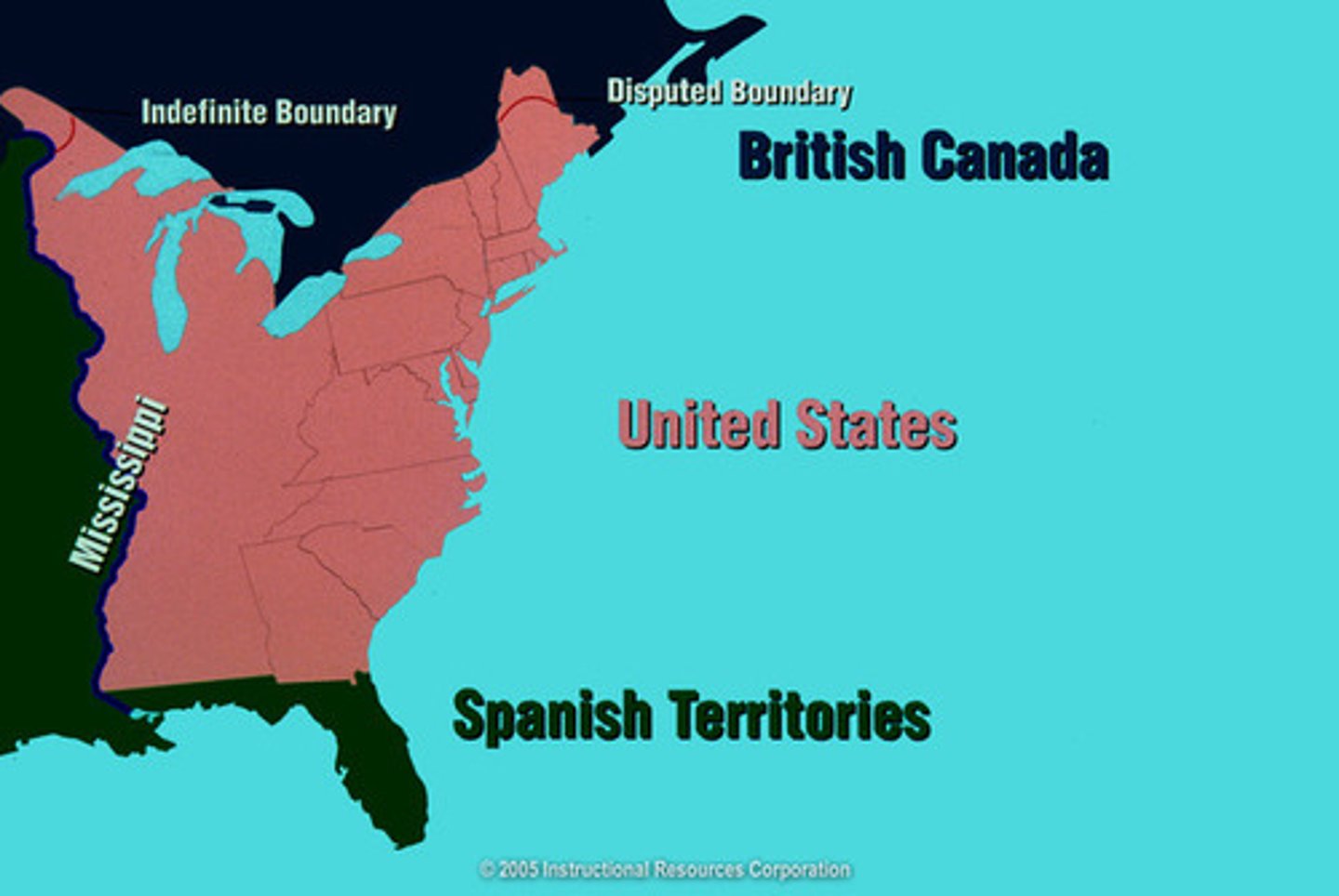
American Exceptionalism
The widespread belief among Americans for centuries that the United States is either distinctive, unique, or exemplary compared to other nations, and it therefor has a special role to serve as a refuge from tyranny, a symbol of freedom, and a model for the rest of the world. There are different versions of this belief--ranging from the scholarly to the propagandistic--but post proponents of the belief argue that a combination of America's values (liberty, egalitarianism, individualism), political system (liberalism, republicanism, constitutionalism, democracy, free-market economics), and/or historical development (its beginnings in an Enlightenment-inspired revolution, its access to a vast continent with extraordinary resources, it's nation of immigrants) have made the nation unique in human history. Some proponents use this belief to argue the U.S. is both destined and entitled to play a distinct and positive role as a global leader on the world stage. To others, the belief is controversial, and many critics believe it is arrogant, chauvinistic, and untrue.
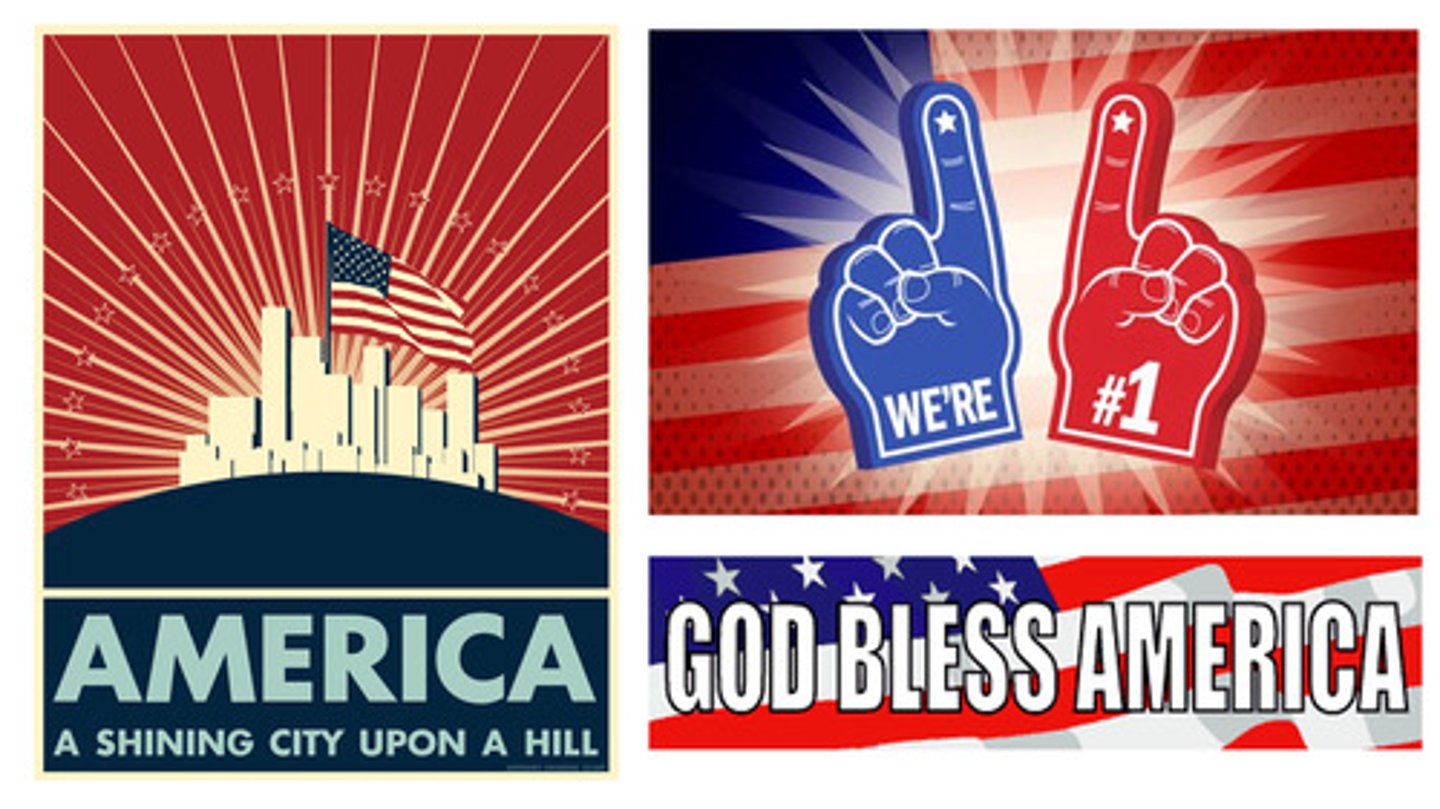
Republic
A system of government in which political authority comes from the consent of the governed and is exercised by representatives of the people. This systems runs in contrast to systems where political authority comes from God ("the divine right of kings") and rulers inherit their positions (as in monarchy and aristocracy). To a large extent, the Age of Revolution witnessed movements throughout the Atlantic World (Britain, the U.S., France, Haiti, Latin America) that aimed to reduce the power of monarchies and aristocracies and establish republics in their place.
property qualifications
These laws required a person to have a set quantity of land or property to be eligible to vote or run for public office because it was believed people would make more responsible and informed decisions regarding governance if they had an economic stake in the community and more to lose from poor policy choices. No country that we would consider democratic today ("one person one vote") existed on earth in the 17th or 18th centuries. But during the Revolutionary Era, many U.S. states slowly began to reduce these laws; while most states retained some of these requirements, the most democratic new constitutions (like Pennsylvania) moved toward the idea of voting as an entitlement rather than a privilege. By the 1780s in the United States, a large majority of adult white males could meet voting requirements, which was far more than anywhere else in the world at the time. Nearly every state abolished these laws by the 1830s, which was a major milestone in the U.S.' journey towards liberal democracy.
The Separation of Church and State
This is the principle, emerging during the Enlightenment and largely implemented during the American Revolution, that governments ought to be secular (non-religious), tolerate religious pluralism/diversity, and should not coerce their citizens to adopt, pay taxes in support of, or attend services for any particular religious faith. During the Revolutionary Era, most states disestablished their churches, and the First Amendment enshrined religious freedom in the U.S. Constitution. Without a doubt, religious minorities could still face hostility and discrimination, and this principle was easier to proclaim as an ideal than to implement in practice. Nevertheless, by overthrowing thousands of years of established practice in civilizations around the world, this was one of the most radical principles to appear during the American Revolution, and its emergence was a major milestone in American liberalism.
Bill Establishing Religious Freedom
Written by Thomas Jefferson, the Virginian's bill was adopted by the House of Burgesses in 1786. It eliminated religious requirements for voting and officeholding in Virginia, and it ended the Virginia government's financial support for churches ("established churches"), and barred the state from "forcing" individuals to adopt any particular religious outlook.
Christian Republicanism
The widespread theory during the Revolutionary Era that religious virtue and morals were necessary for a republic to prosper. Now that Americans were going to govern themselves, many believed, religion would be more important than ever because it provide the public with the virtues they needed to make good, wise, and moral laws. In this way, rather than making religion obsolete, the Revolution actually made religion more important to many Americans.
Adam Smith's The Wealth of Nations (1776)
This Scottish economist, who would become known as "the Father of Capitalism," wrote this early book of economics, in which he argued that the "invisible hand" of the free market, along with the natural laws of supply and demand, directed economic life much more effectively and fairly than governments could (and thus he rejected the prevailing theory of mercantilism). In his book, he observed--crucially-- that new wealth can be created. In other words, the quantity of wealth in the world is not fixed and unchanging. Rather human self-interest and even greed (not generosity and compassion, as many assumed then, and as socialists would assume later) is what actually motivates people to provide the goods and services that their community needs. (The baker makes bread, for example, not out of compassion and generosity, but rather because he will be paid when he sells it!). Additionally, new wealth can be created with "the division of labor," which causes workers to specialize, innovate, and therefor to become far more productive. Like the Declaration of Independence published in the same year (1776), this book advocated ideas that were radical for their time and that have become central to the tradition of liberalism ever since.

Free Trade
This is a market system in which a government neither regulates prices nor production levels, nor restricts imports or exports through tariffs or taxes, but rather the government allows the economy to regulate itself according to the natural laws of supply and demand. This system was first promoted by Enlightenment-era thinkers (such as Adam Smith), and it became a key element of the philosophy of liberalism. The U.S. generally began practicing this economic system when it declared independence from Britain in 1776, thus overturning mercantilism and the Navigation Acts. While this system does produce winners and losers, a broad consensus among economists credits this system for having enormously positive impacts overall on economic growth, living standards, and economic stability over the past two centuries.
Free Labor
This was the labor system that existed in the northern United States during the Revolutionary Era in which individuals were free (not enslaved) to work for wages or run their own farm or shop. In stark contrast to many ancient labor systems such as feudalism, serfdom, and slavery, this new system represented concepts of freedom, individualism, and self-reliance, It attracted immigrants with its egalitarian vision of individual human potential and the idea that anyone could climb the ladder of success with hard work and dedication.
Loyalists
Colonists who remained loyal to Great Britain during the War of Independence. American loyalists included royal officials, Anglican clergymen, wealthy merchants with ties to London, and recent arrivals (especially from Scotland), as well as many ordinary colonists who were conservative by nature and/or felt that the protection of Britain was needed. Colonists with these views accounted for an estimated 15-20 percent of the white colonial population during the American Revolution, compared with those described as "Patriots", who accounted for about 40-50 per cent of the population, and the rest were neutrals. This high level of political polarization leads historians to argue that the American Revolution was as much a civil war as it was a war of independence
Abolition
A radical social movement, drawing on the liberal and Enlightenment ideals of natural rights, that emerged for the first time in the 18th century to challenge an ancient institution practiced for thousands of years on every continent in the world: slavery. Initially led by Quakers and other Christian groups in Britain and the United States, it called for the end of the Atlantic slave trade and the emancipation of enslaved people, sometimes gradually and other times immediately.
Gradual Emancipation
During the Revolutionary Era, all Northern states, adopted these policies in which children of slaves born after a certain date would be freed when they reached adulthood. These laws assumed that former slaves would remain in the country, not be colonized abroad. As a result of these laws, free black people formed their own free communities in the North with their own schools, churches, and leaders, who, in some states, could even vote.
Freedom Petitions
Enslaved African-Americans in the North presented these arguments for freedom and abolition to New England's courts and legislatures in the 1770s, often successfully leading the policies of gradual emancipation. These documents demonstrated how the notions of human equality and liberty that the revolutionary leaders appealed to in the Declaration of Independence could be used by other people in the society to justify their own liberation.
Dunmore's Proclamation (1775)
Issued in 1775 by the British governor and military commander in Virginia, this proclamation offered freedom to any Virginia slave who escaped from their owners and fought for the British. It enraged Virginia's slave owning elite and prompted between one and two thousand slaves to run away from their American owners and join the British (most of these fugitive slaves died from a smallpox outbreak one year later). This act illustrates the multi-sided nature of the American Revolution; for enslaved people, fighting for freedom sometimes meant fighting against the Patriot cause.
Abigail Adams
The wife and closest advisor to John Adams (second President of the U.S.) who educated herself and often contributed her opinions on political affairs. Famously, in a letter to her husband, she urged Congress to "remember the ladies," and she believed that a husband should not have absolute power over his wife. While feminism was only beginning to emerge during her lifetime, and while she did not describe herself as a feminist, she nevertheless was an advocate of married women's property rights (rejecting coverture) and more opportunities for women, particularly in the field of education.
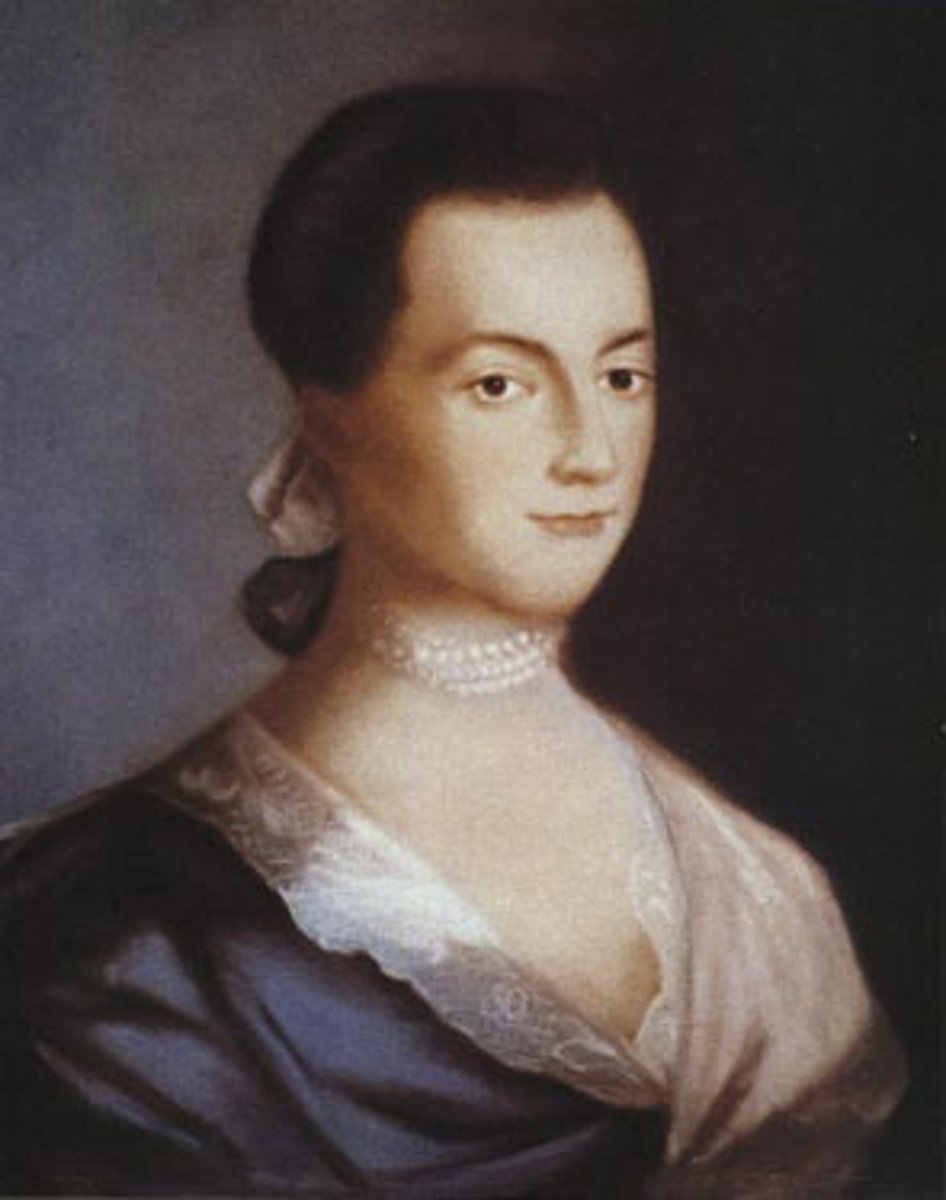
Republican Motherhood
An idea that developed during the American Revolution that women have a patriotic duty to raise children to be proper citizens of a republic. While this idea reinforced the traditional gender role of women as mothers, it also opened up educational opportunities for women and increased their value in society. If women were needed to educate their sons to be patriots capable performing their responsibilities as citizens in a free republic (rather than sons who were simply obedient subjects in a hierarchical monarchy), then women needed to be educated themselves.
The Articles of Confederation
The first constitution, ratified in 1781, whose primary goal was to preserve the independence and sovereignty of the states, created a very weak central government composed only of a one-house legislature that did not have the power to tax, regulate trade, or raise troops (the "three-Ts"). After Shays' Rebellion and calls for a stronger central government, this frame of government was replaced by the Constitution of the United States in 1789.

Northwest Ordinance (1787)
As settlers moved westward during the 1780s, Congress under the Articles of Confederation enacted this policy for admitting new states; it ensured every new state would be republican in form, and it promoted public education, protected private property, and banned slavery in what was then called "the Northwest Territory" (now the "Upper Midwest"). This act reflected Jefferson's vision of an "Empire of Liberty," and by prohibiting slavery, it would have far-reaching consequences when sectional conflict between North and South developed in the mid 19th century.
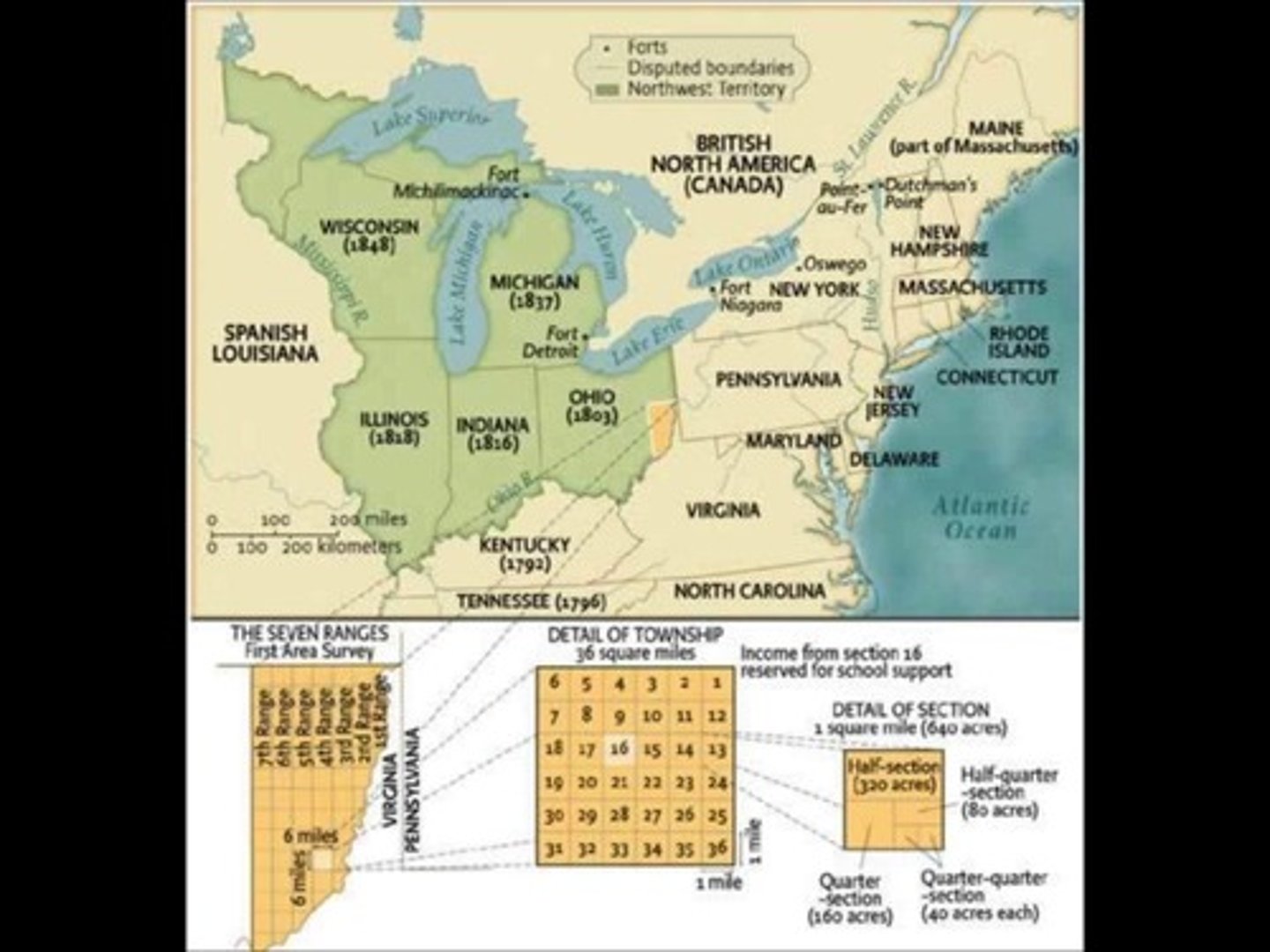
"Empire of Liberty"
As envisioned by Thomas Jefferson and then implemented through the Northwest Ordinance, this was the idea that as the United States expanded west, rather than simply conquering and exploiting western lands and peoples by ruling over them as colonized subjects, instead the U.S. would spread freedom around across the west and around world as it grew, by incorporating new territories and populations as equal members into the United States political system. This was an early element of the notion of American Exceptionalism, and it inspired American expansion throughout the 19th century.
Shays' Rebellion (1786-87)
In 1786 and 1787, crowds of debt-ridden farmers closed the courts in western Massachusetts to prevent the seizure of their land for failure to pay taxes. This event revealed the weakness of the central government under the Articles of Confederation, convinced many (Federalists) that the nation needed a stronger national government, and it emerged as a major cause of the Constitutional Convention in 1787.
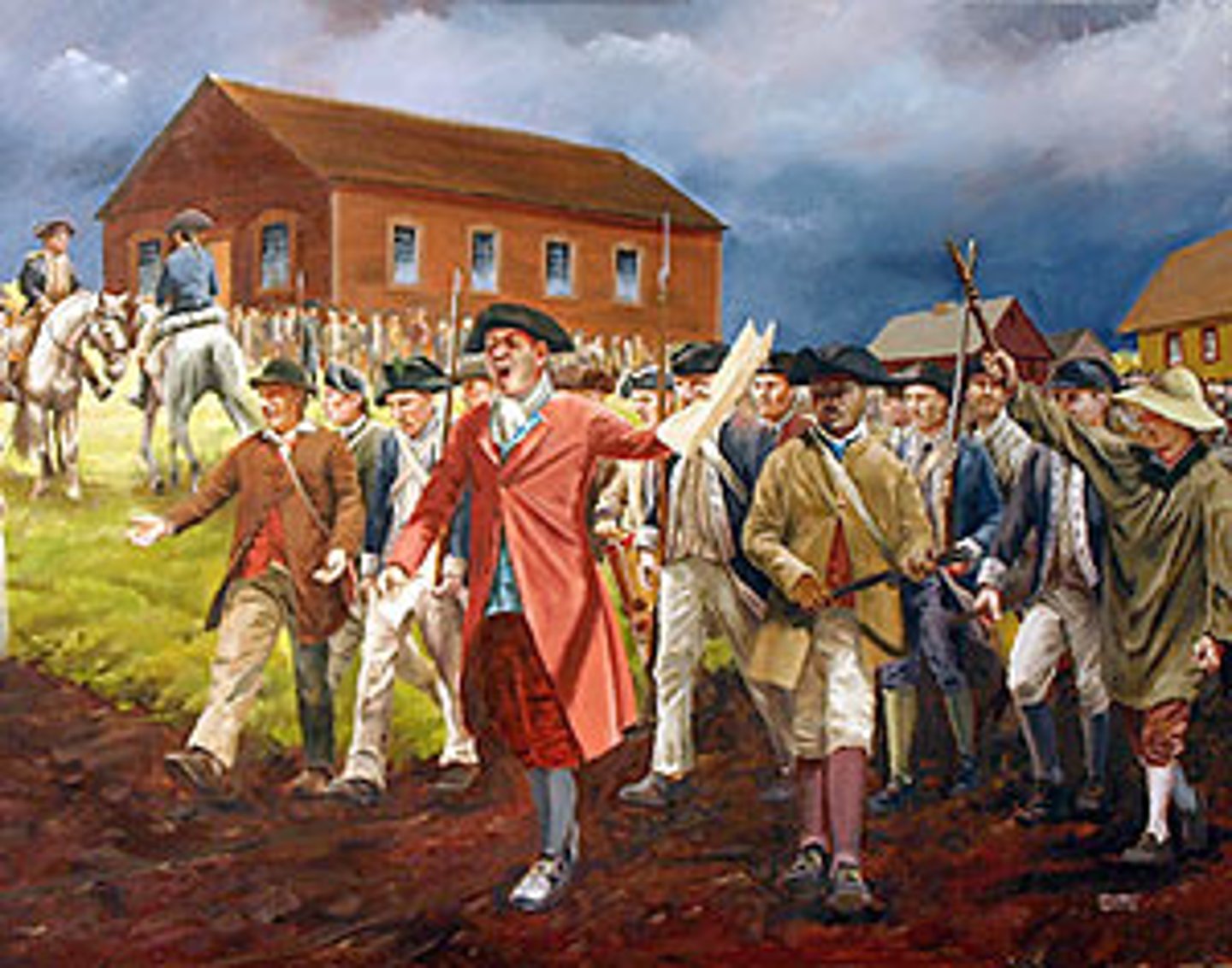
Checks and Balances (aka "Separation of Powers")
The central feature of the U.S. Constitution in which distinct powers are given to executive, legislative, and judicial branches of the national government, and each branch has specific powers it may use to limit or check the powers of the other two branches so that no one branch can dominate and become tyrannical. This idea emerged during the Enlightenment, reflecting the rejection of monarchy, and it is credited with having ensured the survival of U.S. Constitution (the oldest living constitution on Earth) because of its realistic recognition that human nature is flawed, people in government are susceptible to greed and corruption, and therefor constitutions must be designed to prevent those in government from abusing their power.
Examples in the U.S. Constitution include: The President may veto of Congressional legislation (which Congress may override by a two-thirds vote). Congress may impeachment the President, or a judge. The President appoints the members of the Supreme Court, but only with the consent of the Senate. Congress declares war, but the President is the Commander and Chief of the military. The Senate must approve treaties that the President makes with foreign countries. And the Supreme Court may exercise the power of judicial review to ensure that actions of the President and Congress are constitutional.
Federalism (aka "Division of Powers")
A key feature of the U.S. Constitution that distributes political power between two levels of government: the national government (aka "the federal government) and many state government. The national (or "federal") government has specified powers that include regulating foreign and interstate commerce (business conducted across state lines), coining money, conducting foreign relations and making treaties, making and enforcing immigration policy, declaring war, and maintaining the armed forces. On the other hand, state governments are responsible for day-to-day things like regulating intrastate commerce (business conducted within the state), maintaining schools and roads, and issuing licenses and permits. Because the Constitution does not clearly delineate the boundaries between many state and federal powers, a common theme in U.S. history is conflict between state and federal government.
The Federalist (aka The Federalist Papers)
A collection of eighty-five essays that appeared in the New York press in 1787-1788 that made the argument in support of the Constitution (which had yet to be ratified) and argued the Articles of Confederation were deficient. They were written by Alexander Hamilton, James Madison, and John Jay and published under the pseudonym "Publius." The Federalist Papers are considered one of the most important sources for interpreting and understanding the original intent of the U.S. Constitution, as well as one of the most significant American contributions to the field of political philosophy and the theory of republican government.
The ⅗ Clause
A compromise provision of the Constitution that allowed sixty percent of the enslaved population to be counted in determining each state's representation in the House of Representatives and its electoral votes for president. Misconception alert: this clause did not make a claim about the value of enslaved people relative to free people (as many students often incorrectly assume!). Rather, this clause was a compromise between northern and southern states over how many representatives each state would have in the House of Representatives. (Slave states wanted to count slaves as full persons so they would have more power in Congress, whereas abolitionists and Northerners did not want to count slaves at all because they were not being represented by southern politicians.)
The Fugitive Slave Clause
This clause in the U.S. Constitution said that enslaved people who run away are not free but shall be returned to their owners. The Constitution didn't use the word "slave" or "slavery" at all, but along with the 3/5ths Clause, and the protection of the Atlantic slave trade until 1808, this clause was one of the key protections of slavery in the Constitution.
The Elastic Clause
Also known as "the Necessary and Proper Clause," this Constitutional provision allows Congress to exercise "all powers necessary and proper for carrying into execution all . . . powers vested by this Constitution in the Government of the United States." Advocates of a powerful federal government have used this constitutional amendment for centuries to justify loosely interpreting the Constitution and expanding the role of the national government.
The Electoral College
A group selected by the states to elect the President and the Vice President, in which each state's number of electors is equal to the number of its senators and representatives in Congress. At the time of the Constitutional Convention, no other country in the world directly elected its chief executive/President. Some delegates insisted on a democratic popular vote, while others argued that Congress should pick the President. Eventually, the founders compromised by designing this system which would enable the people to have influence in selecting the President while simultaneously maintaining a process to prevent "the excesses of democracy."
Supremacy Clause
This part of the U.S. Constitution (Article 5, Clause 2), establishes that the U.S. Constitution, federal laws made pursuant to it, and treaties made under its authority, are the "supreme Law of the Land", and take priority over any conflicting state laws. Essentially, it means actions by the federal government trump actions by the state government when the two conflict. This is considered the cornerstone of America's system of federalism.
Bill of Rights (1791)
The first ten amendments to the U.S. Constitution, adopted in 1791 to guarantee individual rights against abuse by the federal government. Devised in the debate over ratification of the U.S. Constitution in order to address the concerns of the Antifederalists that the Constitution would endanger the freedoms of the people, these amendments guaranteed specific personal freedoms and rights (including speech, press, assembly, religion, and bearing arms), and they clearly limited the government's power in judicial and other proceedings (by protecting rights against unwarranted search and arrest, rights to a fair trial, and rights against unreasonable fines and punishment, etc.). The basic rights it guarantees have come to define our nation and the core rights of citizens in a liberal and free society.
The First Amendment
Enshrining into the U.S. constitution the core human rights that are necessary for a liberal and democratic society, this Amendment states: "Congress shall make no law respecting an establishment of religion, or prohibiting the free exercise thereof; or abridging the freedom of speech, or of the press; or the right of the people peaceably to assemble, and to petition the Government for a redress of grievances." These rights were unique to the United States at the time of their enactment in 1791, and in the early 21st century, they still remain only a distant hope for billions of people around the world.
The Tenth Amendment
"The powers not delegated to the United States by the Constitution, nor prohibited by it to the States, are reserved to the States respectively, or to the people." For centuries, state's rights advocates have used this amendment to justify strictly interpreting the text of the Constitution and limiting the power of the national government.
Federalists and Antifederalists
The two main groups composing the debate over the ratification of the Constitution from 1787 and 1789. The first group favored ratification of the Constitution because it would create a stronger national government. The second group opposed ratification of the Constitution arguing that it would threaten individuals' and states' rights; their demands led to the addition of the Bill of Rights to the document.
Nationalism
An ideology that emerged in the 17th and 18th centuries, alongside the Enlightenment, that claimed that "the people" ought to be "citizens" of a "nation" with the right to rule themselves, and it rejected empires or monarchies that ruled over their "subjects" without concern for their interests. (For example, the preamble of the U.S. Constitution evokes "We the People" as the source of national sovereignty.) Historians often claim that nations are "imagined communities" that strive for "self-determination" or "popular sovereignty." There are different forms of nationalism, and many of the conflicts in U.S. history over who should be, and should not be, considered "American" can be understood as conflicts between ethnic and civic nationalism.
Ethnic Nationalism
Any ideology that defines membership in a "nation" by one's identification with a specific ethnic group or shared ancestry. Thus, belonging to the nation is determined by whether or not one has the required cultural traits such as language, religion, ethnic or racial ancestry, customs and traditions. This was the most common form of nationalism when it first emerged in the 18th and 19th centuries, and it is still the most common form nationalism takes around the world today (some current examples include Japan, Russia, India, and Turkey). In U.S. history, it tends to be promoted by white supremacist organizations (like the KKK), but there are exceptions. For example, many Native American nations practice this form of nationalism, and Black Nationalists see black people whose ancestors descended from Africa as a distinct "nation." In diverse multi-ethnic states like the U.S, ethnic nationalism excludes many people in society from membership in the nation.
Civic Nationalism
A form of nationalism that adheres to traditional liberal values of universal freedom, tolerance, equality, and individual rights, and is not based on ethnocentrism. Also known as "liberal nationalism" or "democratic nationalism," this ideology defines membership in the nation by one's commitment to the nation's political institutions (such as the U.S. Constitution) and ideals (in the U.S. these include liberty, equality, democracy, the rule of law, etc.), regardless of one's ethnicity, race, religion, language, or ancestry, etc. In diverse multi-ethnic states like the U.S, this form of nationalism can include everyone in the society. The claim that the United States is a "nation of immigrants" is a classic statement of civic nationalism.
Treaty of Greenville (1795)
As a result of the Native American loss the the United States in the Battle of Fallen Timbers in 1795, this treaty ended the was and twelve Indian tribes ceded much of the '"Old Northwest" (modern day Ohio, Indiana and Michigan) to the federal government, and it established a system of annuity payments to the Indians. The "Annuity" system was a system of yearly grants of federal money to Indian tribes that institutionalized continuing government influence in tribal affairs and gave outsiders considerable control over Indian life.
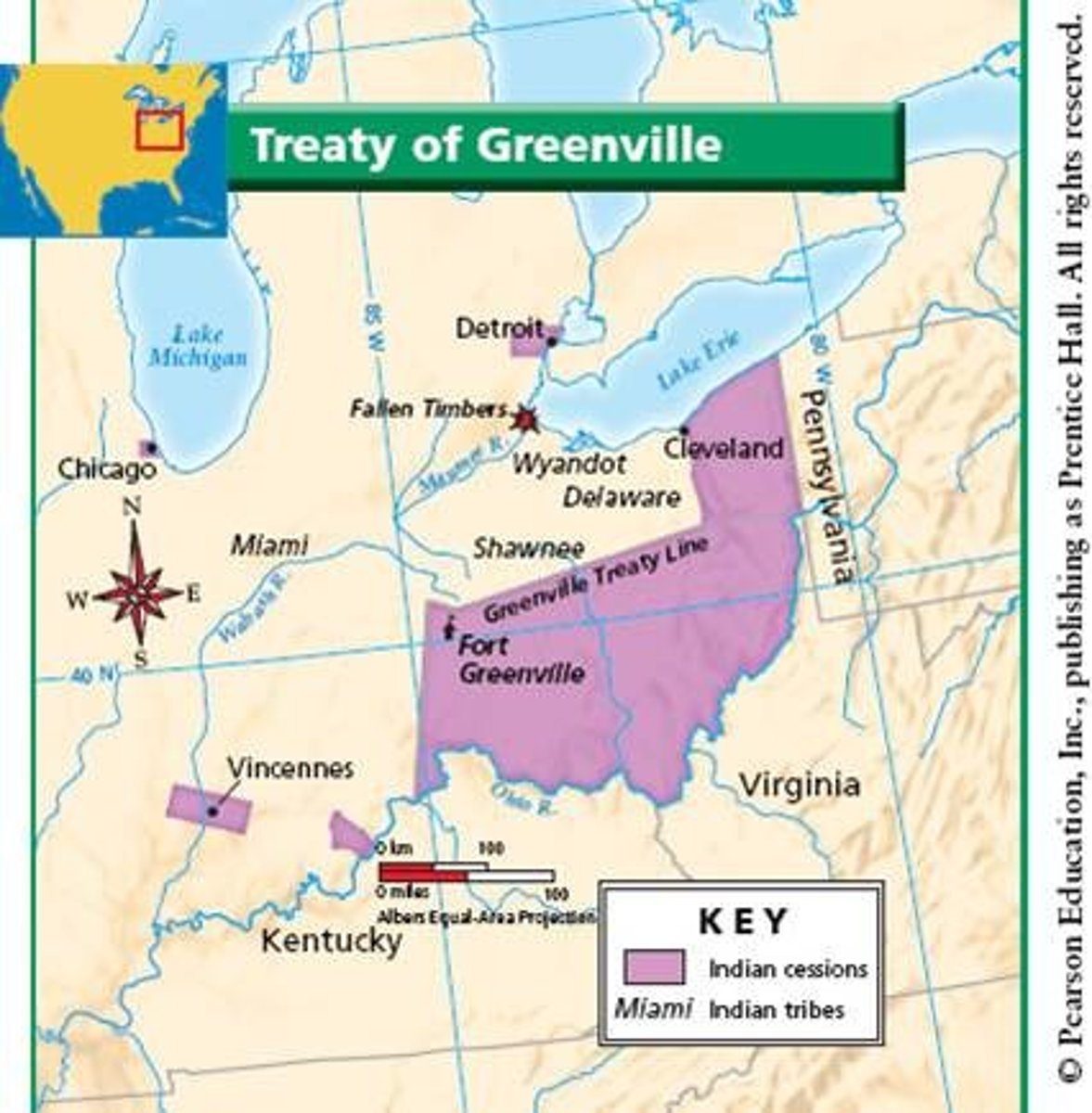
Open Immigration
For most of the nineteenth-century, this was America's immigration policy; anyone who wished to immigrate to the U.S. could. The U.S. had the fastest growing population in the world in the 19th century as it became an increasingly multi-ethnic, multi-religious, multi-linguistic "nation of immigrants." Additionally, anyone considered "white" was eligible to claim American citizenship, unless they were unwilling to renounce hereditary titles of nobility. The United States retained this policy until the 1880s, when it imposed its first barrier on Chinese immigration.
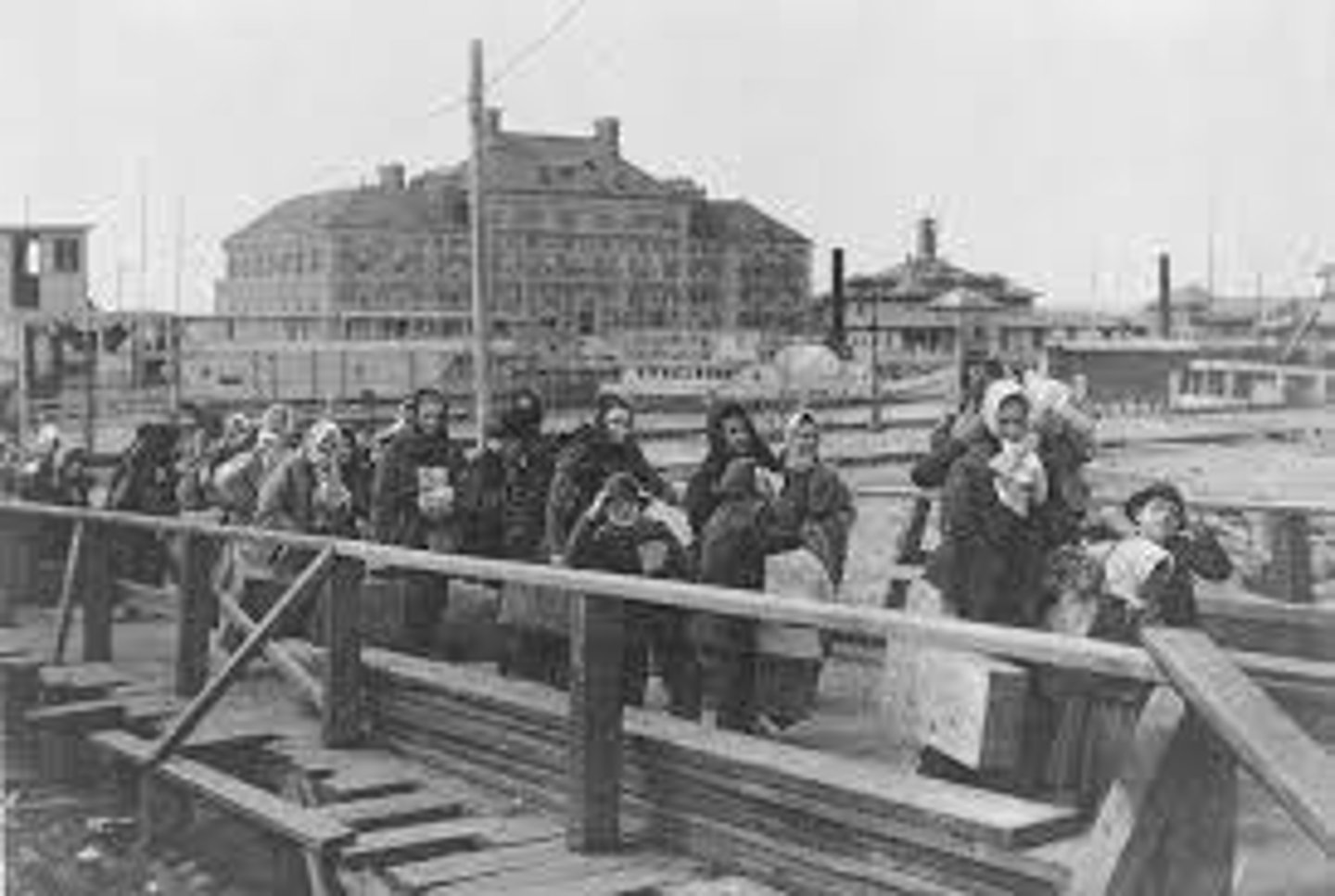
Alexander Hamilton's Five-Point Financial Plan (1790-1791): 1) Pay off the old debt, 2) Create new national debt, 3) Create a B.U.S., 4) Whiskey Tax, 5) Protective Tariff
Alexander Hamilton, the Secretary of the Treasury, aimed to establish the nation's financial stability, bring to the government's support the country's most powerful financial interests, and encourage economic development, which in the long run, he hoped, would transform the nation into a major commercial and military power. Hamilton's plan provoked major divisions between what would soon become the two political parties of first party system (Federalists and Republicans). Federalists supported the plan because they promoted a stronger national government, economic industrialization, an active role for the government in the economy, and the interests of upper class northerners. On the other hand, Republican mostly opposed the plan because they favored strong state governments, an agricultural economy, minimal government economic intervention, and the interests of farmers and the South. Republican ended up allowing for the passage of Hamilton's Plan in exchange for relocating the nation's capital to Washington D.C. (which is in the South).
The Bank of the United States
Proposed by the first Secretary of the Treasury, Alexander Hamilton, this received a charter to operate for twenty years (1791-1811) by issuing uniform national currency, making loans to businesses, and collecting taxes for the government. The second one was chartered in 1816 but President Andrew Jackson vetoed the recharter bill in 1832. Very controversial. Supporters said this institution helped to unify, industrialize, stabilize, and nationalize the economy. Opponents said it was corrupt, unconstitutional, and hierarchical. The battle over this institution can be understood as a battle between active-state liberalism and limited-state liberalism.
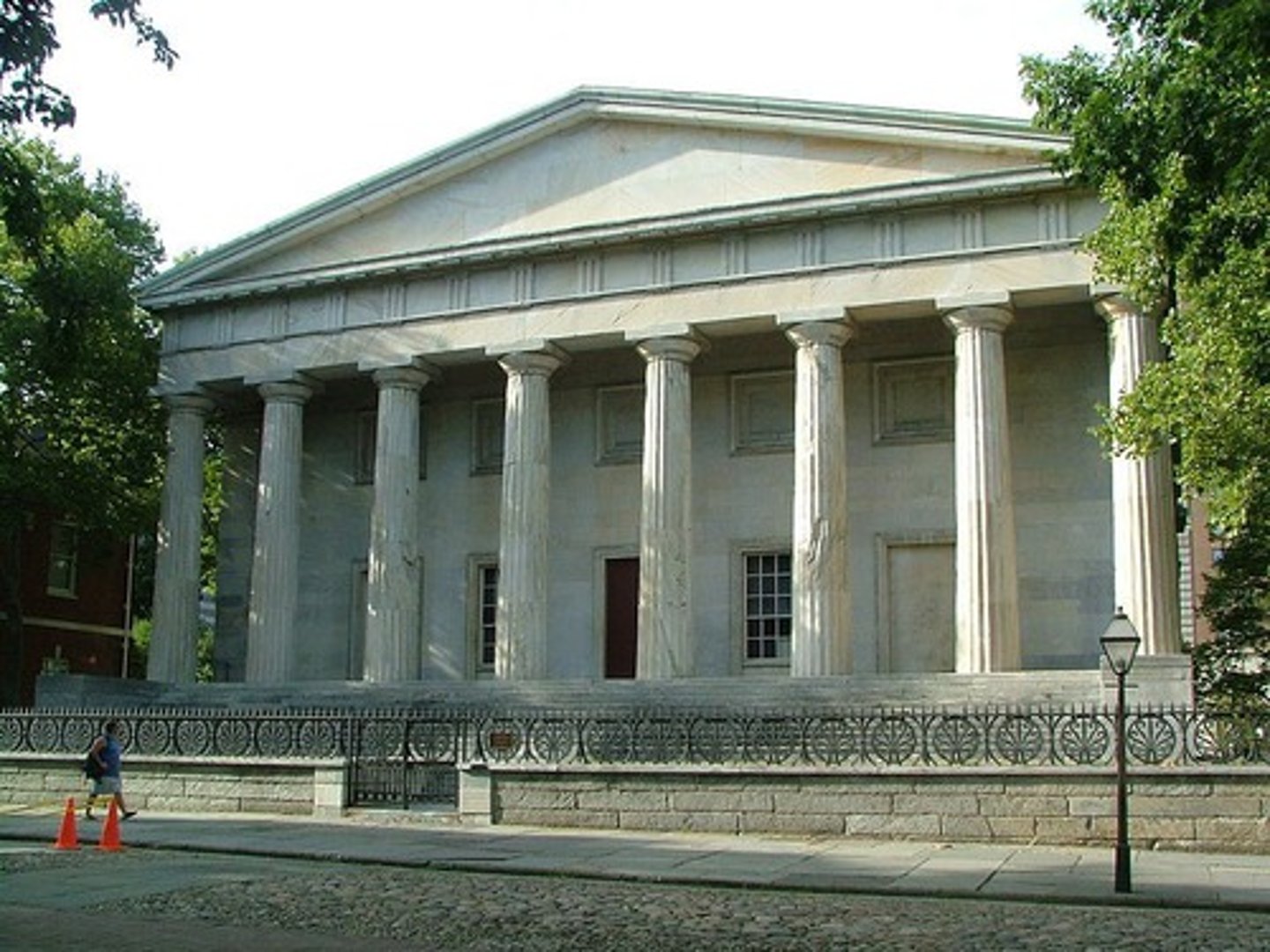
Strict Constructionists
Those who apply a limited and literal interpretation of the Constitution. In the 1790s, these were mostly
Southerners who opposed Hamilton's program, insisting that the federal government could only exercise powers specifically listed in the Constitution. (The Constitution says nothing about a Bank of the United States.)
Federalists and Republicans
The two major political parties that had appeared in Congress by the mid-1790s (the first Party System). The first were supporters of the Washington administration, favored Hamilton's economic program and close ties with Britain. The second, led by Jefferson and Madison, were more sympathetic to France and had more faith in democratic self-government.
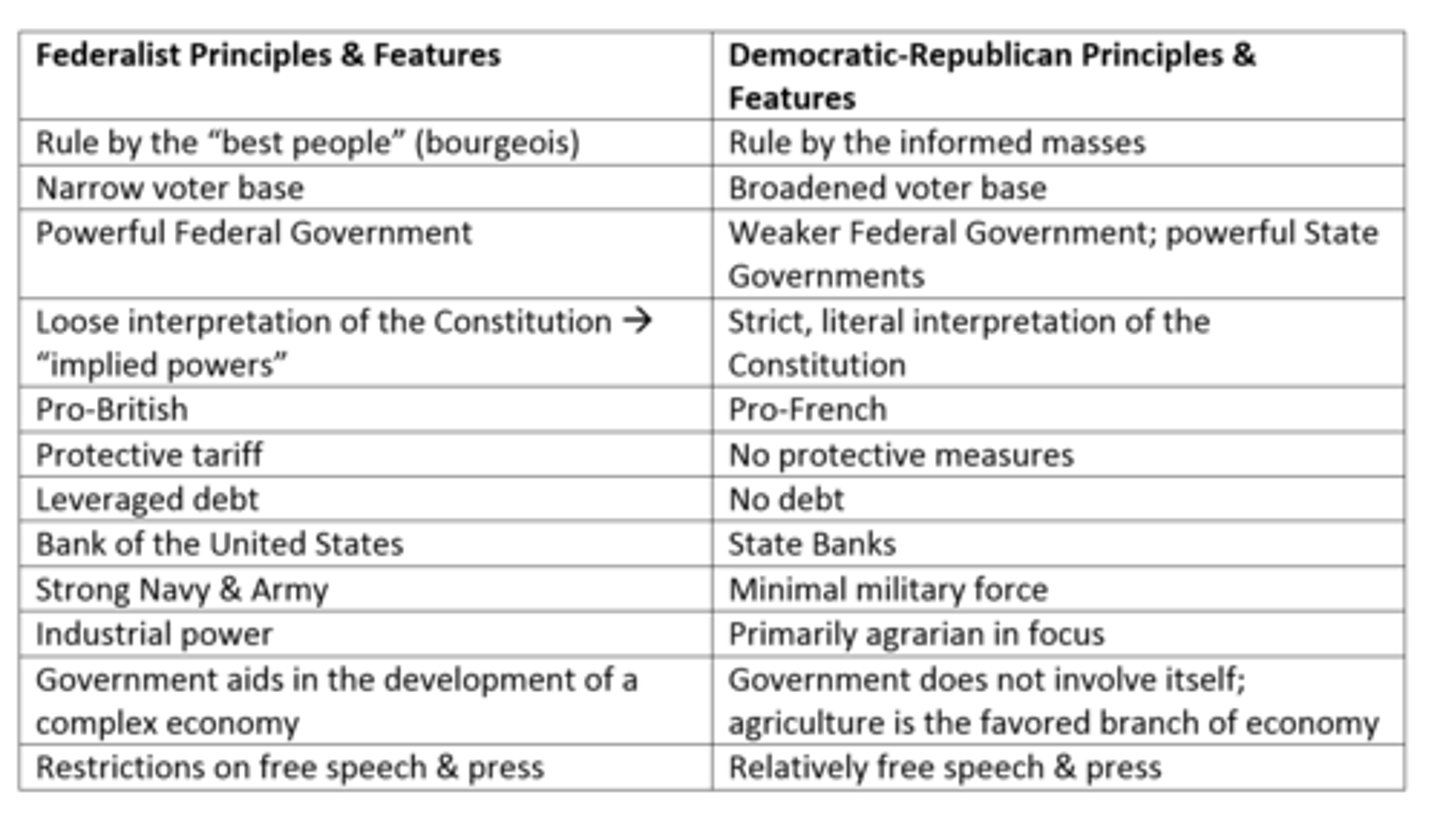
Whiskey Rebellion (1794)
Violent protest by western Pennsylvania farmers against the federal tax on whiskey, 1794. The Rebellion was put down by a forceful response from the Washington Administration. Washington's response demonstrated the power of the new national government and was a stark contrast to the impotent response of the national government to Shay's Rebellion in 1787 under the Articles of Confederation.

Judith Sargent Murray, "On the Equality of the Sexes" (1779)
An early American advocate for women's rights, an essay writer, playwright, poet, and letter writer. She was one of the first American proponents of the idea of the equality of the sexes so that women, like men, had the capability of intellectual accomplishment and should be able to achieve economic independence.
Among many other influential pieces, her landmark essay "On the Equality of the Sexes" paved the way for new thoughts and ideas proposed by other feminist writers of the century. In it, she argued that women had as much right as men to exercise their talents and should be allowed equal educational opportunities to enable them to do so. She demonstrates how women could take the notions of human equality and liberty that male revolutionary leaders evoked in the Declaration of Independence and use them to justify their own liberation.
The Alien and Sedition Acts, 1798
Laws supported by John Adams and the Federalists to protect national security during the undeclared war with France in order to restrict the freedoms of speech and press and restrict the liberty of non-citizens. These laws authorized the prosecution of virtually any public assembly or publication critical of the government (directed at leaders of the Republican press) and extended the time it took to become a citizen (directed at immigrants from France who were becoming Republicans). These laws were extremely controversial and opposed by the Republicans. They reflect the perennial tensions between civil liberties and national security in liberal societies.
Virginia and Kentucky Resolutions, 1798-99
Written by James Madison and Thomas Jefferson, supported by Republicans, and passed by the legislatures of two Southern states, these statements argued that the Alien and Sedition Acts were unconstitutional, and they argued for states' right and strict construction of the Constitution. They reflect the perennial tensions between civil liberties and national security in liberal societies.
Haitian Revolution
The worlds first and only major successful slave rebellion, lasting throughout the 1790s, in the French Caribbean slave colony of Saint Domingue, led by Toussaint L'Ouverture, an educated slave on a sugar plantation, that established the independent nation of Haiti, persuaded Napoleon to sell his remaining American land holdings to the U.S. (the Louisiana Purchase), and struck fear in the minds of U.S. slaveholders who worried it would inspire more slave rebellions. Despite the Haitian revolutionaries use of the Enlightenment-era revolutionary language to overthrow its colonial rulers, and end slavery, the U.S. nevertheless refused to officially recognize Haiti and instead imposed devastating economic sanctions on the island.
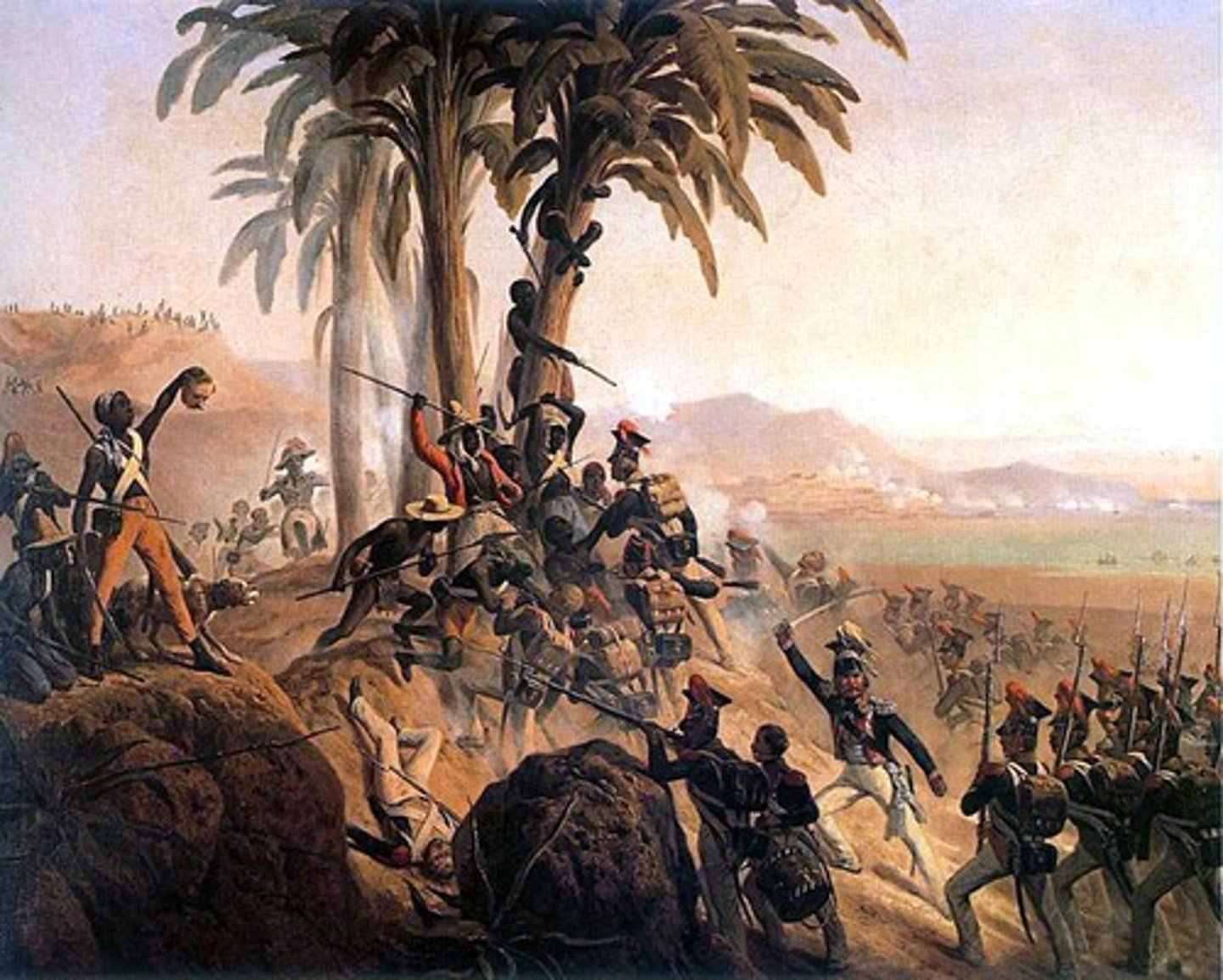
Gabriel's Rebellion, 1800
An unsuccessful plot to launch a slave uprising in Virginia that was organized by an enslaved blacksmith and his brothers, in which the slaves involved hoped to gain their freedom. Information regarding the revolt was leaked before started, and the planner of the uprising, along with twenty-five of his followers, were captured and hanged. Alarmed by the potential for widespread violence and chaos, Virginia and other state legislatures passed restrictions on free blacks, as well as prohibiting the education, assembly, and hiring of enslaved people, to prevent future rebellions. This event represented the chasm between the ideal of liberty and the reality of bondage for enslaved Americans.
The "Revolution of 1800"
The Presidential election that resulted in the first peaceful transition of power in the United States from one political party to another, proving that a republic could function in the modern world. After his defeat, John Adams (a Federalist) recognized the legitimacy of the election and allowed Thomas Jefferson (a Republican) to take over the Presidency of the United States. This precedent began a pattern of peaceful transitions of power following elections that has lasted over two centuries and has become one of the greatest hallmarks of American democracy. Only after the 2020 Presidential election was this tradition called into question in the United States for the first time.
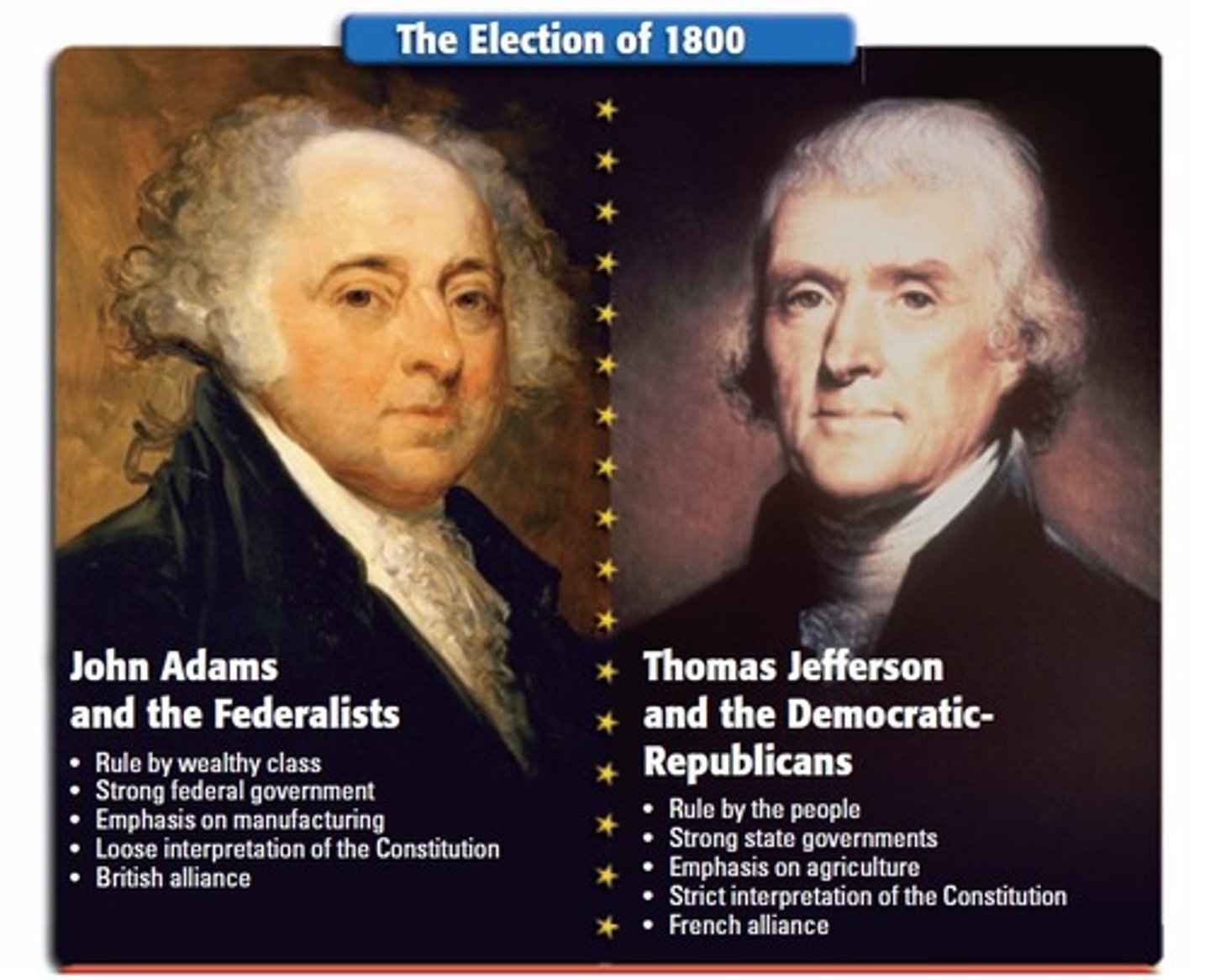
Loyal Opposition
This term refers to a minority political party (within a two-party system like that of the United States) whose opposition to the party in power is understood to be constructive, responsible, and bounded by loyalty to the fundamental interests and principles of the nation. In other words, in a liberal society, a citizen can be opposed to the political party in power while still remaining loyal and committed to the nation at large.
Marbury v. Madison (1803)
First U.S. Supreme Court decision to declare a federal law unconstitutional. This case established the principle of "Judicial Review," or the power of the Supreme Court to declare a law unconstitutional. The power of judicial review is not mentioned in the Constitution, yet it has become the most powerful "check" (among the Checks and Balances) the judicial branch of government holds. (Note: Always italicize titles of court cases and put a v. in the name)
The Louisiana Purchase (1803)
President Thomas Jefferson's 1803 purchase from France of the important port of New Orleans and almost one million square miles west of the Mississippi River to the Rocky Mountains. It more than doubled the territory of the United States at a cost of only $15 million. Jefferson, like most Republicans, had been a "strict constructionist" in the 1790s while he opposed Hamilton's Financial Plan, but he had to adopt a "loose interpretation" of the Constitution in order make this deal.

The Lewis and Clark Expedition (1804-1806)
An expedition to explore the new territory acquired by the Louisiana Purchase. It sought to discover how the region could be exploited economically, establish trading relations with western Indians, and locate a water route to the Pacific Ocean, and map the biodiversity and geography of the newly acquired Louisiana Purchase.
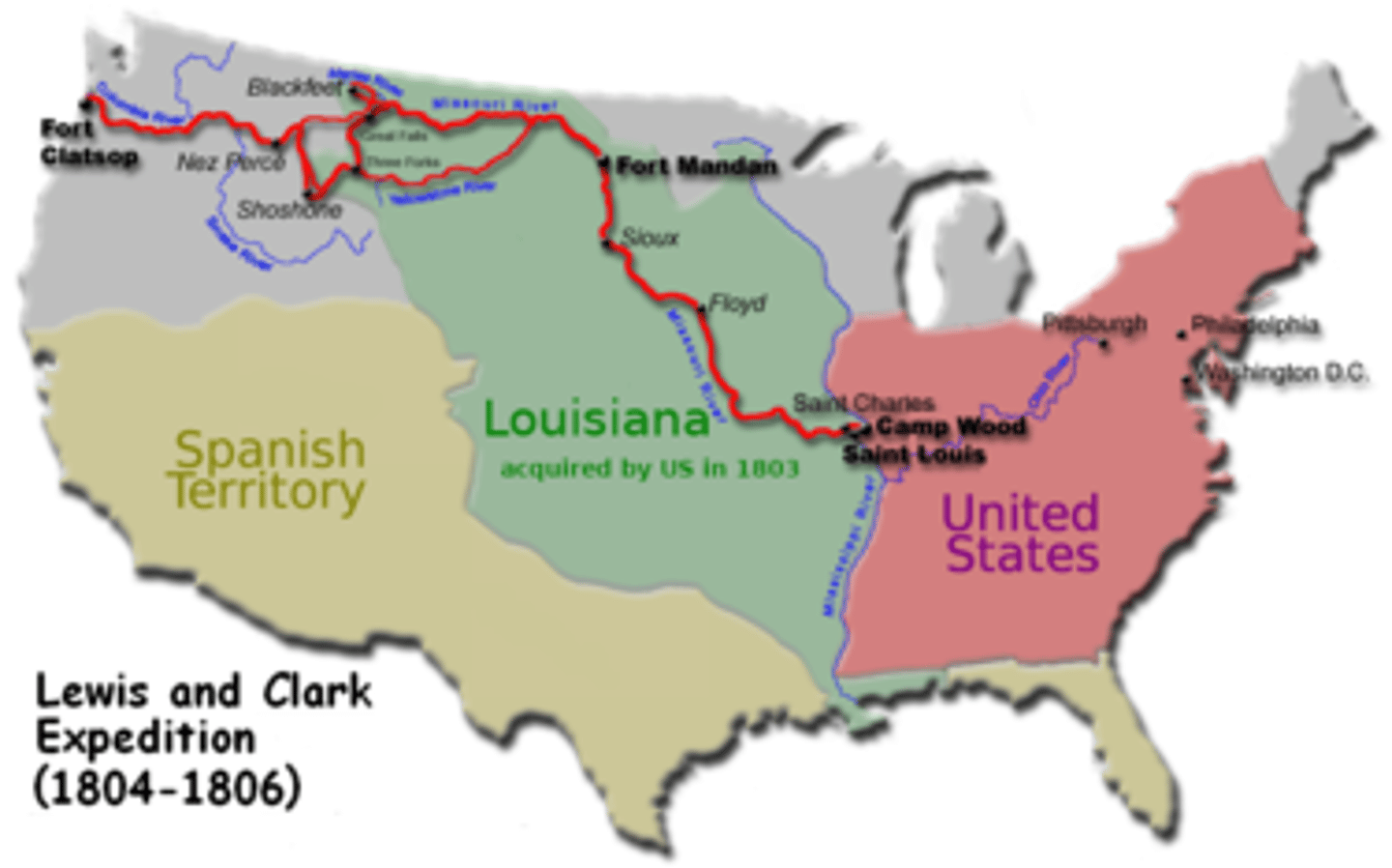
Embargo Act (1807)
President Jefferson's failed attempt to avoid war with England (which had been impressing/kidnapping American sailors on American ships trading with Europe) by prohibiting all American ships from trading in foreign ports in hopes that this economic pressure would force England to relent. It didn't work. Smugglers easily circumvented the embargo, and it was repealed two years later.
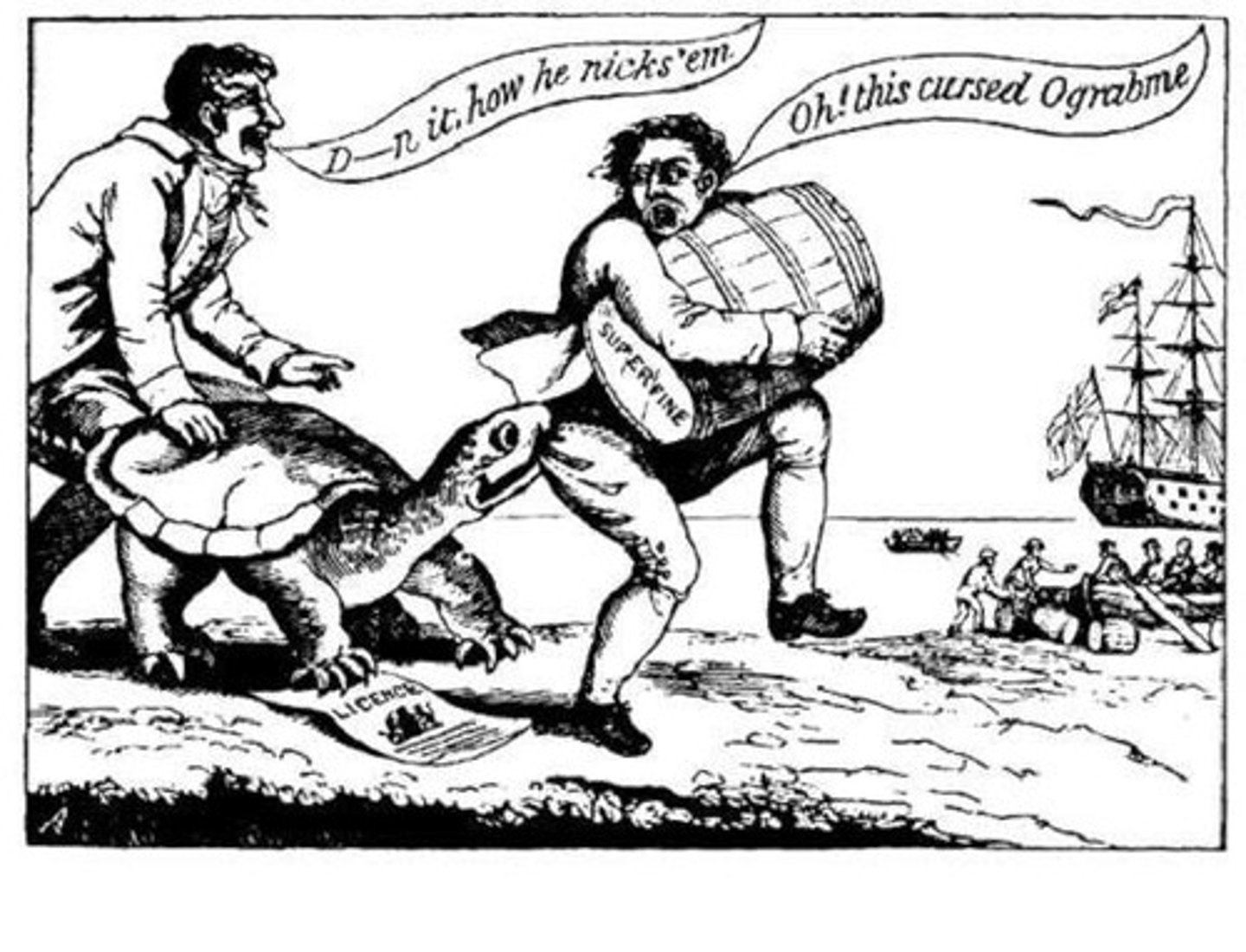
Tecumseh and Tenskwatawa
During the Early National Period, these were two Shawnee brothers who called for the revival of traditional Indian culture, the unification of separate Native American tribes into a pan-Indian alliance, and armed resistance to the expansion of the U.S. settlers into traditional Indian lands in the old Northwest Territory. They were defeated during the War of 1812.
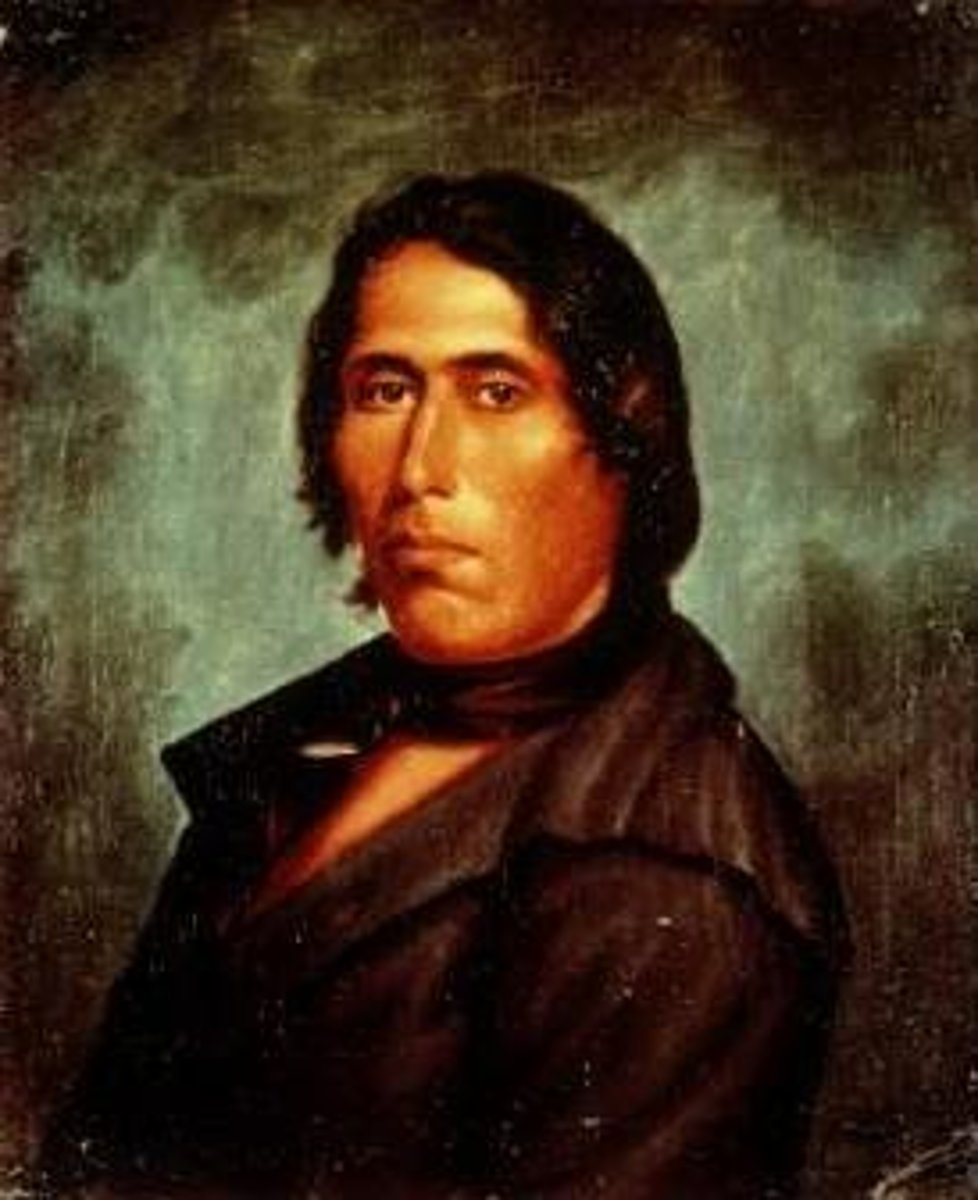
The War of 1812
Fought with Britain, between 1812-1814, over issues that included impressment (kidnapping) of American sailors, interference with American shipping, and collusion with Northwest Territory Indians. The war was settled by the Treaty of Ghent in 1814, removed the British and Indians as a threat to American western expansion, increased American nationalism, brought an end to the Federalist Party (because of the Hartford Convention) and made Andrew Jackson a famous war hero.

The Hartford Convention, 1814
Meeting of New England Federalists to protest the War of 1812. It gave voice to the party's long-standing grievances, especially the domination of the federal government by Virginian (Southern) presidents and their own region's declining influence as new western states entered the union. But when this convention ended just before news of Andrew Jackson's electrifying victory in the Battle of New Orleans, the Federalists looked unpatriotic. Within a year, their party no longer existed. This event marked the end of the Federalist Party and the first party system.